Fes El-Bali: We did not get fazed by the epic maze of Medina of Fez | Morocco, Africa
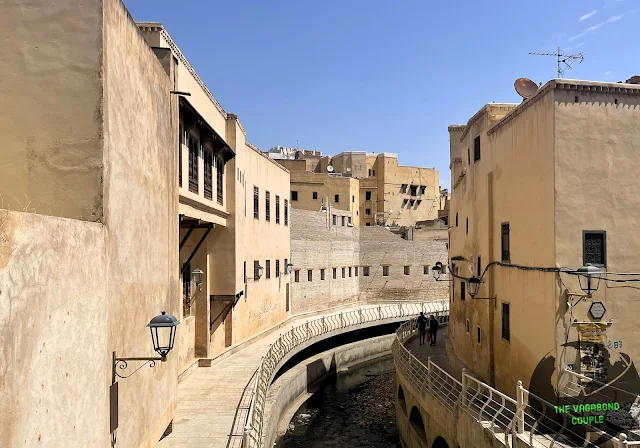 |
| Khrachfiyine Pont on Bou Khrareb river, Medina of Fez |
After an epic sunrise camel ride back from our desert camp on Erg Chebbi dunes at Merzouga (see The Great Sahara of Morocco) and an unforgettable road trip from Merzouga to Fes over High and Middle Atlas mountain ranges and river valleys (see Merzouga to Fes Desert Road over High & Middle Atlas Mountain Ranges), we reach the ancient walled medina of Fez, the legendary Fes el Bali, at 5 PM.
The entire medina of the ancient 9th century city of Fes is a UNESCO world heritage site for good reason. "Founded in the 9th century, Fez reached its height in the 13th-14th centuries under the Marinids, when it replaced Marrakesh as the capital of the kingdom. The urban fabric and the principal monuments in the medina - madrasas, fondouks, palaces, residences, mosques and fountains - date from this period. Although the political capital of Morocco was transferred to Rabat in 1912, Fez has retained its status as the country's cultural and spiritual centre", say UNESCO.
Fes el-Bali, a magical 1.15 square miles in area, encloses within its ancient walls over 13,000 historic buildings including 11 theological schools of Islamic studies (madrasas), 320 mosques, 270 dars (B&Bs and hostels) and funduqs (inns and hotels), and over 200 Moorish bathhouses and hammams connected by over 10,000 pedestrian-only streets, a vast majority of which are really narrow 3-foot wide alleys. About 160,000 people live inside Fes el-Bali today. Automobiles are not allowed inside, making it the world’s largest car-free medieval city.
The Neighborhoods of Fes
The city of Fes, Morocco is divided into two main districts or quarters: Fes el-Bali (Old Fes) and Fes el-Jdid (New Fes).
Fes el-Bali is the oldest part of Fes and is a UNESCO World Heritage Site. It is a maze of narrow streets and alleyways lined with shops, restaurants, and mosques. Fes el-Bali is also home to several important historical landmarks, such as the University of Al Quaraouiyine, the Bou Inania Madrasa, and the Attarine Madrasa.
Fes el-Jdid is the newer part of Fes and was founded in the 13th century. It is home to the Royal Palace, the Mellah (Jewish quarter), and several other important historical landmarks, such as the Batha Museum and the Bab Bou Jeloud (Blue Gate).
In addition to these two main neighborhoods, Fes is also divided into several smaller neighborhoods, such as Ziat, Batha, R'cif, Bou Jeloud, Nejjarine and Talaa Kbira. These smaller neighborhoods each have their own unique character and attractions. For example, Ziat is known for its traditional Moroccan houses and gardens, while Batha is home to the Batha Museum and the Blue Gate. R'cif is a bustling neighborhood with a large market, while Bou Jeloud is known for its woodworkers and metalworkers. Nejjarine is a traditional neighborhood with a leather tannery and a copper market, while Talaa Kbira is a major shopping street.
Here is a map of incredible rues, derbs and alleys we walked to explore the medina of Fes and its unforgettable monuments and shrines of Fes el-Bali (link to full map).
Welcome to Fes el Bali
July 15, 2023
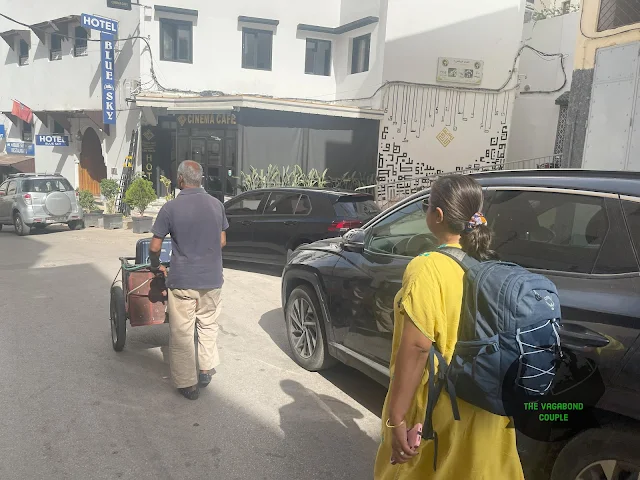 |
| Cart Rental at Fes el-Bali |
Only pedestrians and two-wheelers are allowed in the maze of narrow alleys of Fes el-Bali. Our driver from Merzouga drops us off next to Batha Fountain at Cinema Cafe on Rue Sidi El Khayat just outside the wall of the medina. We have to walk to our riad (B&B / hotel, house with central courtyard and rooms around) at the center of the old medina from here.
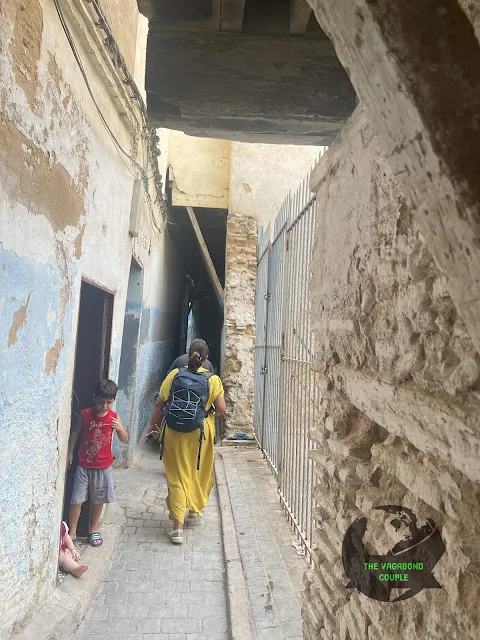 |
| Traversing alleys to our riad (dar) in Fes el-Bali |
Fortunately there are people here who load luggage onto little two-wheeled carts which they manually push to whatever riads, dars or funduqs tourists are heading to. The person and the cart are both collectively called "cart" one of which we hire to take us and our luggage to our riad that is at the center of walled old town.
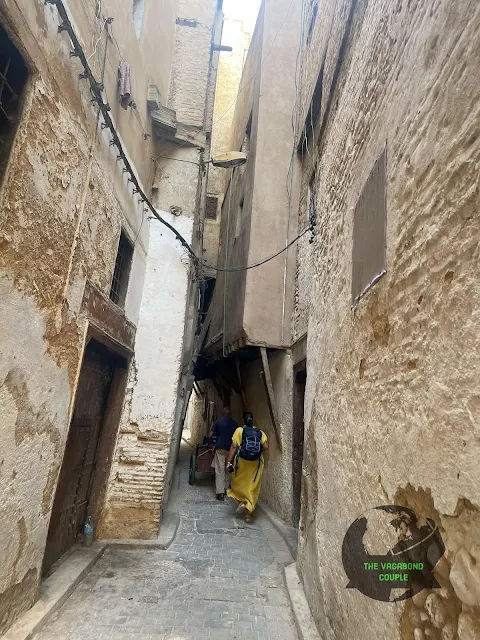 |
| Traversing alleys to our riad (dar) in Fes el-Bali |
The cart service of Fes el-Bali immediately elevates our comfort level above that in Marrakech where we had to haul our own luggage over sprawling Jemaa el-Fna in desert heat and were scammed into paying for directions (see Marrakech: Daughter of the Desert and Atlas Mountains).
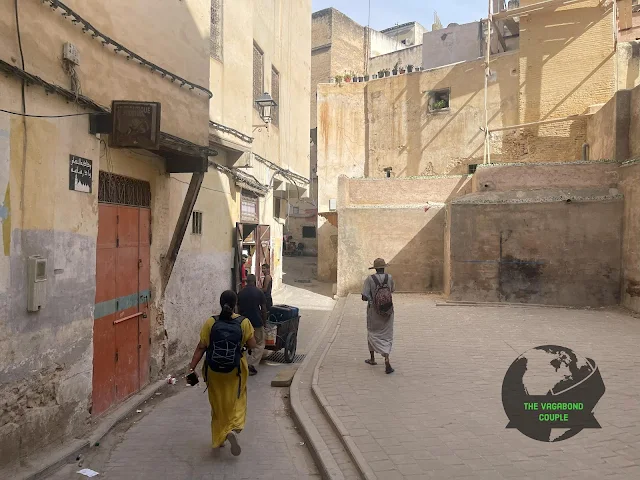 |
| Traversing alleys to our riad (dar) in Fes el-Bali |
The cart service costs U$ 3 going in because it is mostly downhill to the old city. As we will find out later, a trip back out is a more laborious uphill journey costing US$ 5.
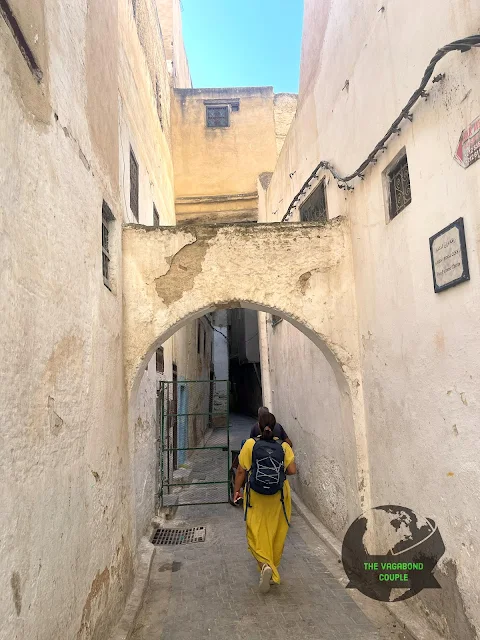 |
| Traversing alleys to our riad (dar) in Fes el-Bali |
Another great advantage of renting a cart is we do not have to figure out how to get to our riad in the maze of alleys.
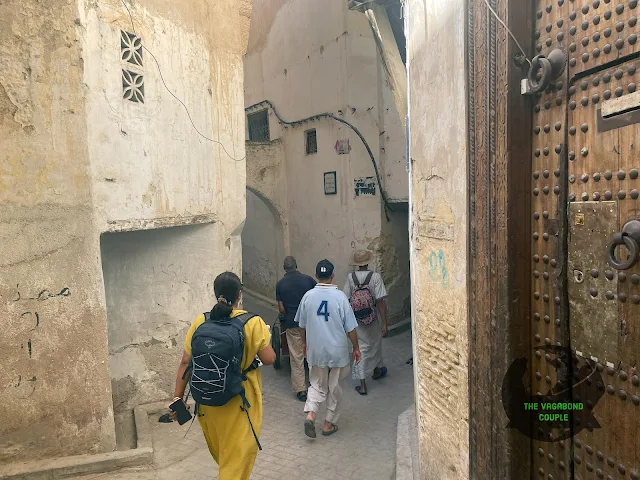 |
| Traversing alleys to our riad (dar) in Fes el-Bali |
We follow our cart marvelling at the incredible old city over a good 40-minute walk to our riad. Of course once we reach our riad we have to figure out how we got here to be able to go out and explore the old town with reasonable hope of returning to our beds for the night.
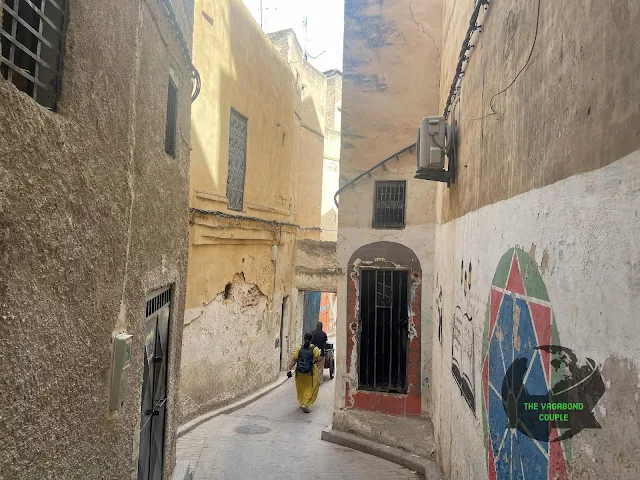 |
| Traversing alleys to our riad (dar) in Fes el-Bali |
We have explored ancient alleyways from Greece to Turkey but never ever been in a place like this. The Medina of Fez is on a different level of delightfully confusing chaos, architecture, art and complexity altogether!
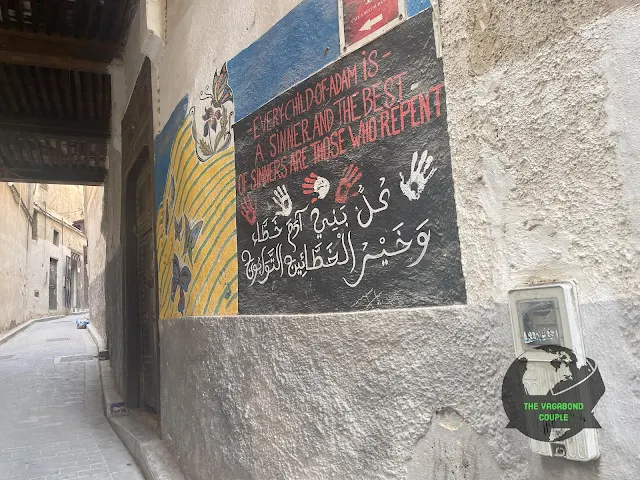 |
| Traversing alleys to our riad (dar) in Fes el-Bali |
Our first experience with Fes el-Bali is enhanced by following our cart taking a path down numerous alleys between houses, small squares and intersections that do not exist on Google Maps but ultimately resulting in a shorter walk for those who know their way around here.
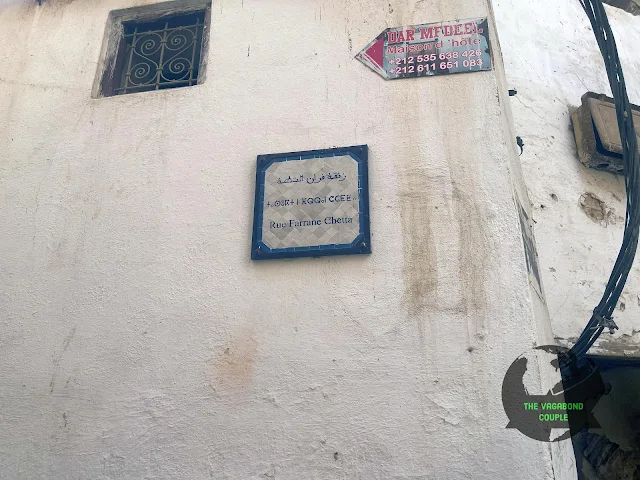
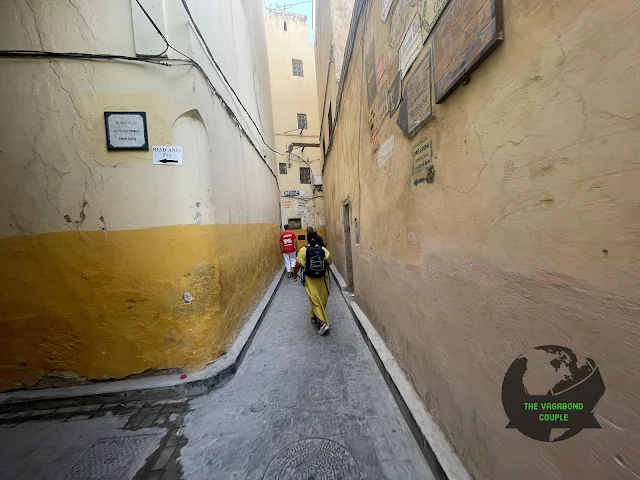 |
| Continuing through the maze of alleys to our riad! |
Our riad is one of Fes el-Bali's numerous dars (houses with central courtyard) that offers rooms to tourists. Perhaps due to lingering effects of the pandemic, we are the only guests in the 7 or so available rooms. We are given the best room of the dar: the only room on the roof terrace with a small courtyard looking out over the medina of Fez.
 |
| Entrance door of Dar Mfaddel |
We check in to our B&B. The inside of our dar is exquisite.
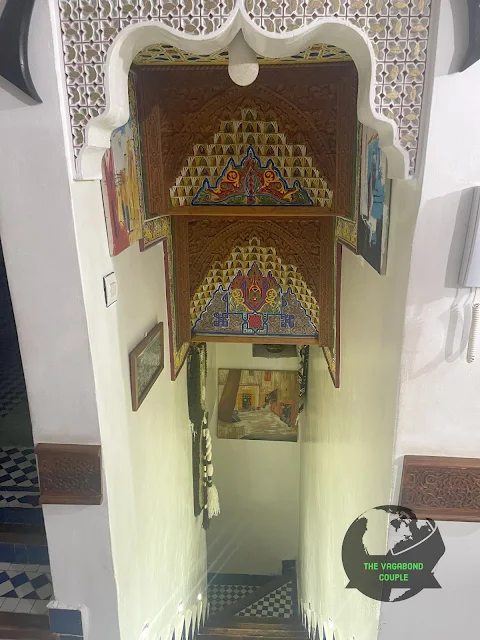 |
| Dar Mfaddel |
Dar Mfaddel is owned and run by Hicham and his wife who are an extremely friendly couple but speak French and Arabic far more fluently than English. They welcome us with homemade snacks and mint tea which we happily gulp down while completing the paperwork.
 |
| Dar Mfaddel |
The final flight of stairs leads to the third-floor terrace on the roof. The steps are way more steep than we are used to. The last three steps need special attention due to being especially narrow and turning sharply. Even the widest part of these final steps are smaller than our feet.
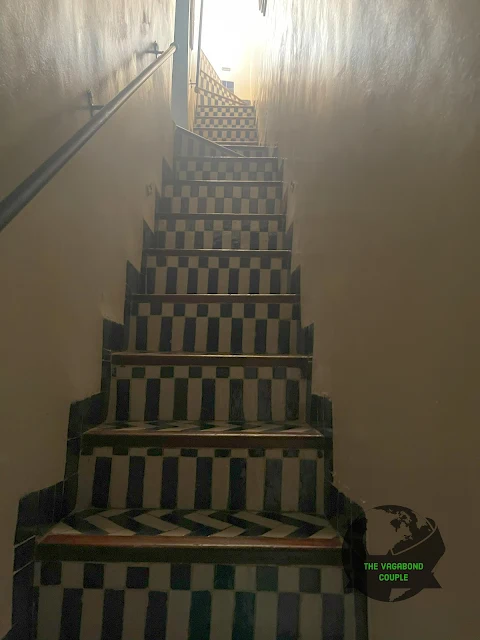 |
| Dar Mfaddel: Stairs to the roof (terrace) room |
Hicham is kind enough to haul our luggage up to our room. We would have otherwise had great trouble climbing those last few stairs with our luggage ourselves.
The terrace itself is beautiful. The room is comfortable with air-conditioning and tiny but clean and fully functional attached bathroom with plenty of available hot water.
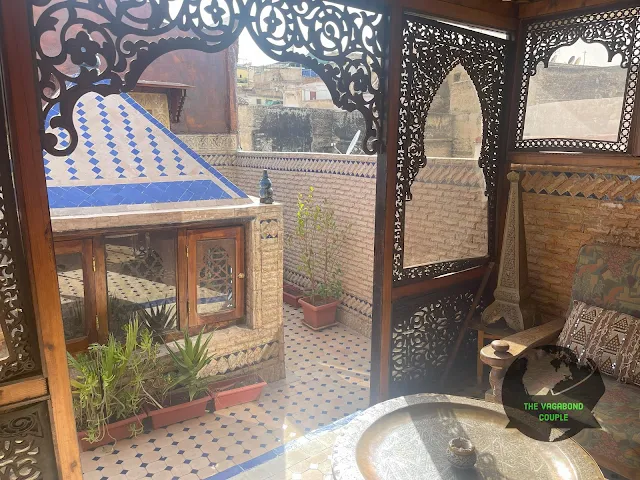
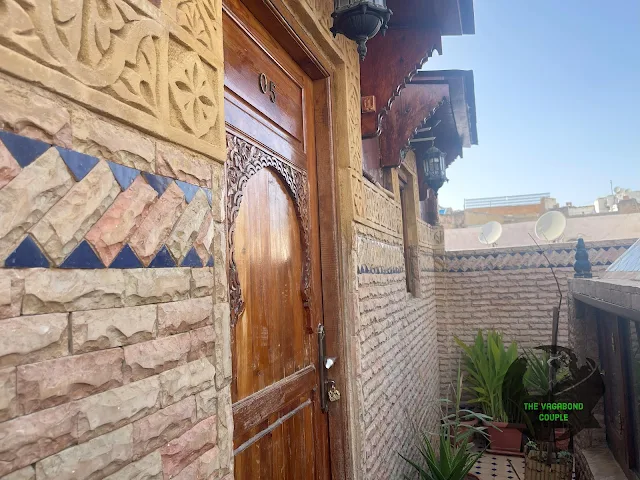 |
| Penthouse terrace room on roof of Dar Mfaddel |
There is a view of the Medina of Fes from our penthouse lodging.
 |
| Views of Fes el Bali from roof terrace of Dar Mfaddel |
We head out a bit later in the evening for dinner and walk down derb (street) Agoumi Zkak Lahjar next to our dar. As we learned in the medina of Marrakech (see Marrakech: Daughter of the Desert and Atlas Mountains), every neighborhood of these ancient Moroccan walled cities has a saqaaya (fountain) at its entrance for people to perform ablution (traditional washing of face, hands and feet in Islamic culture) before entering. This particular saqayya at the intersection with derb Agoumi Zkak Lahjar is called "Fontaine el-Hassaniya".
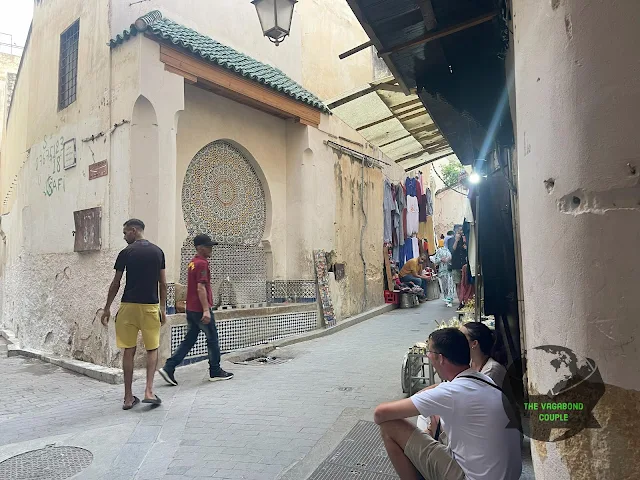 |
| Fontaine el Hassaniya |
 |
| derb Agoumi Zkak Lahjar |
We head towards a Moroccan restaurant called "Dar Khabya" which is up this street according to google maps. This is also our first opportunity to have a little shopping fun in the medina of Fez.
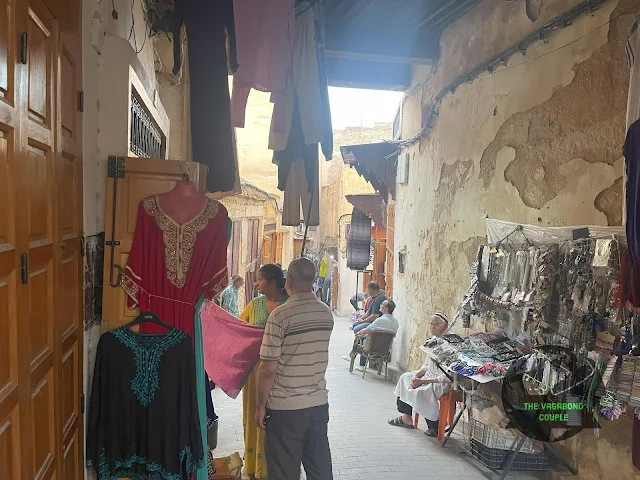 |
| derb Agoumi Zkak Lahjar |
A local young boy senses we are looking for dinner and insists on taking us to his house. He also tells us Dar Khabya is closed. We follow him into his house and up the stairs to their terrace to find an open-air restaurant on the roof with a parapet around it. We missed the name of this roof-top restaurant but it is at 34°03'51.5"N, 4°58'36.9"W.
 |
| Rooftop restaurant on derb Agoumi Zkak Lahjar |
The terrace restaurant is wholly run by the family of the house. Children of the family speak excellent English. One of the young daughters brings us a menu and takes our order.
There are excellent terrace-top views of Fes el-Bali for us to marvel at while waiting for food. We can see the tall minaret of R'cif Mosque. Is that the minaret of Bou Inania Madrasa at the horizon?
 |
| Panorama of Fes el-Bali from rooftop restaurant on derb Agoumi Zkak Lahjar |
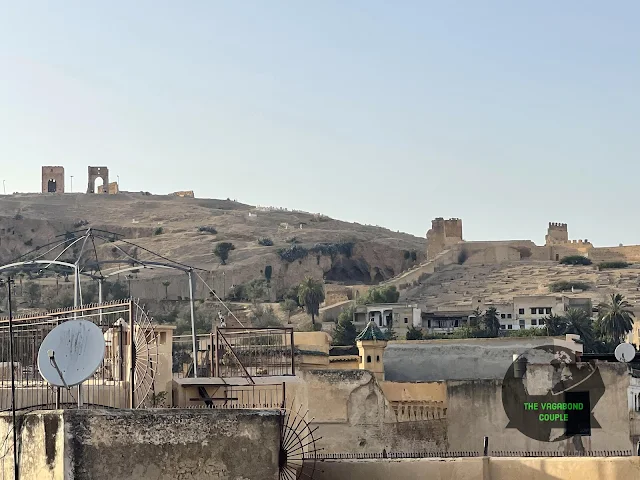 |
| View of Fes el-Bali from rooftop restaurant on derb Agoumi Zkak Lahjar |
The bill for a lavish dinner for the two of us comes in at Moroccan Dirham equivalent of US$ 25. Running short of Moroccan dirhams, we want to pay in US dollars, that too with a $100 bill hoping to get change back in dirhams. We ask one of the daughters to see if we can speak to her father. The sweet little girl initially reacts with apprehension asking us if something was wrong with the food and the service. She is visibly relieved when we explain the reason we need to talk to a grown-up.
The young girl fetches her dad. The father is then joined by an uncle and we work out a decent deal for the exchange rate, getting back 750 dirhams in cash which is significant amount of money in Morocco.
By the time we get back to our dar, it has become eminently clear that we will be totally lost in Fes el-Bali without a guide. It is quite late at about 10 PM but we call Hicham anyway to request help with having a guide meet us here the very next morning. Despite the very short notice, Hicham does not hesitate to tell us a guide will pick us up at 9 AM in the morning and he will charge us US$ 50 to take us on a six-hour (or less if we wish) walking tour of Fes el-Bali.
A long day that started on the Erg Chebbi wind-blown sand dunes in Merzouga comes to an end. We hit the bed tired but anticipating the next day with excitement.
July 16, 2023
Fes el Bali is quiet at dawn. A gentleman on a bicycle comes through the alley with loaves of bread. A lady buys bread from him on the derb. He then delivers a bag full of bread to our dar, leaving the bag at the door.
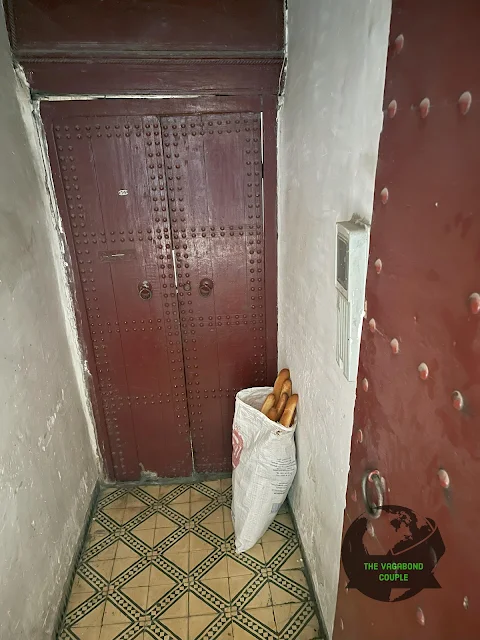 |
| Early morning bread delivery |
A house cat smells fresh bread.
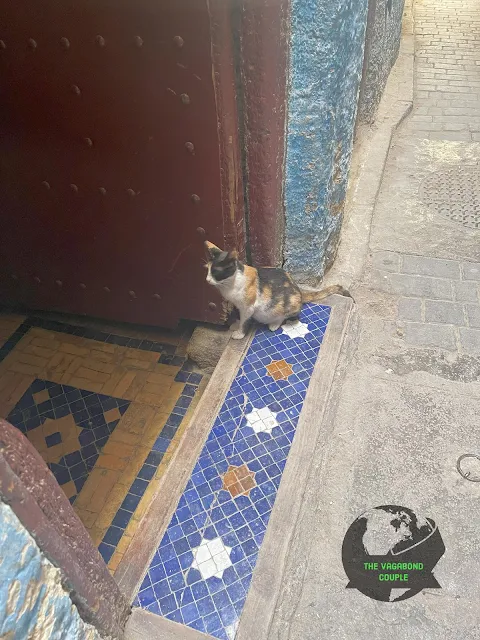 |
| Cat |
An excellent breakfast is cooked and served hot by Hicham himself. Our guide arrives punctually at 9 o'clock and we start exploring the medina of Fez.
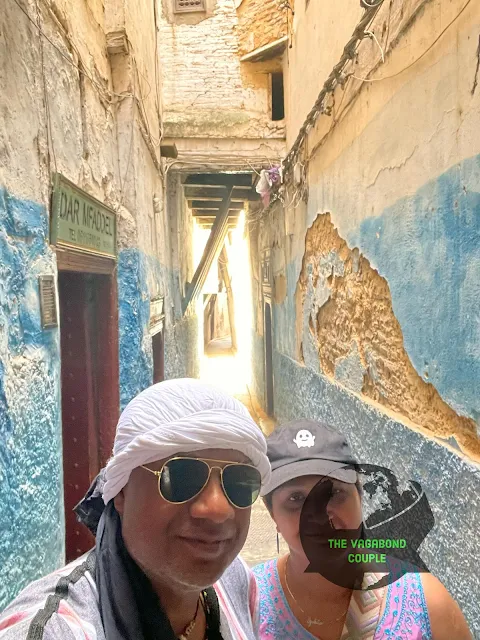 |
| Leaving for Fes el-Bali walking tour |
Outside the Medina of Fez: Fontaine Batha
We start by heading back west to the general area of the Batha Fountain just north of Oued (river) Zibal. This will take us close to where we were dropped off yesterday outside the old city.
We get our first lesson of navigating the alleys of Fes el-Bali from our guide. Street names in hexagonal signs convey dead ends and those in rectangular signs are thruways. For example the following sign says Derb Smiyet Sidi is a dead end.
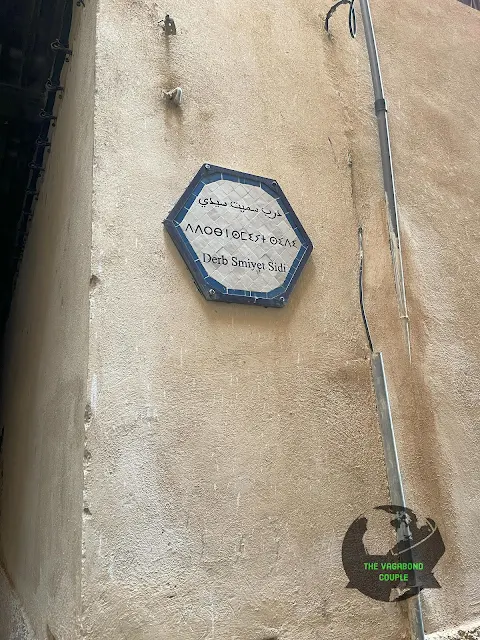 |
| Hexagonal road sign representing a dead end |
In the following example, the sign for Derb Sidi Ahmed Chaoui says it is not a dead end. The French "Rue" and Arabic "Derb" are used interchangeably in Morocco to refer to "street".
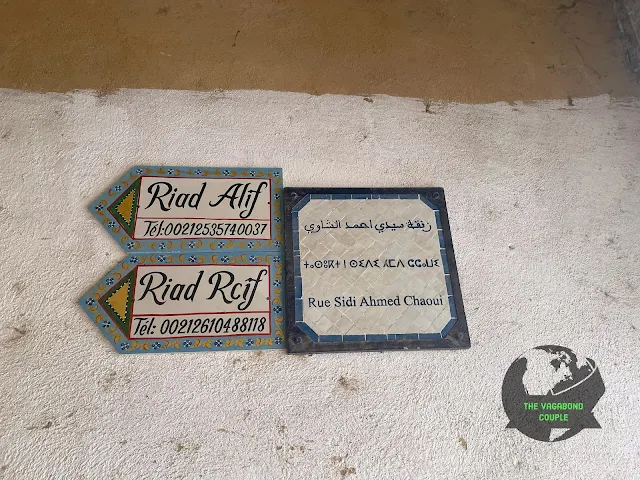 |
| Rectangular road sign indicated throughway (not dead end) |
We continue west.

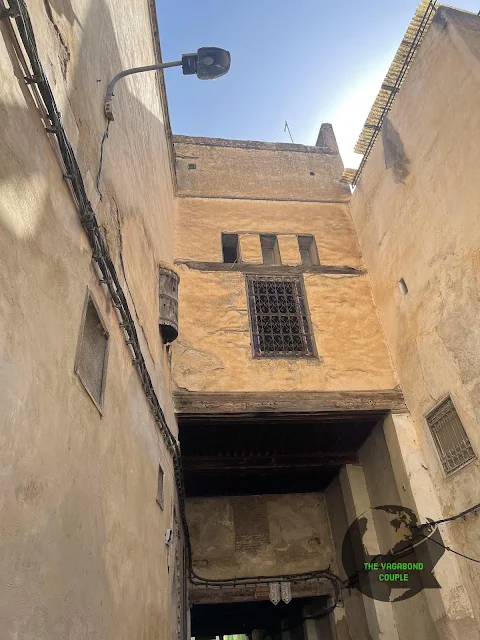
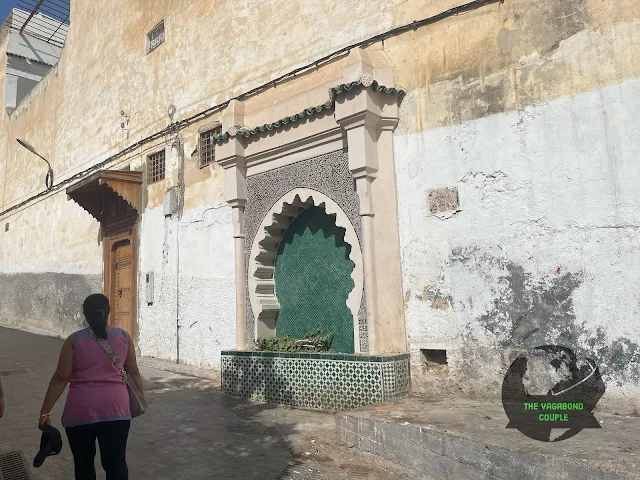 |
| Alleys from Dar Mfaddel in middle of medina to Batha Fountain outside medina of Fez |
We reach a pretty square the intersection of Ave de La Liberte and Rue El Douth. The decorated doors of Heritage Boutique Hotel are on one side of the square.
 |
| Fes heritage boutique hotel |
We head north to Morocco's Proclamation of Independence Monument (Monuments de manifestation de l'indépendance). A large replica of handwritten Manifesto of Independence of Morocco of January 11, 1944 in Mabsout Maghrebi script is displayed here. "On January 11, 1944, with the outcome of World War II still uncertain to all but the most perceptive, 66 Moroccans signed the public proclamation demanding an end to colonialism and the reinstatement of Morocco's independence, an enormous risk at the time", says wikipedia. "Among the signatories were members of the resistance, symbols of a free Morocco, and people who would become key figures in the construction of the new Morocco."
January 11 is an official government holiday in Morocco.
 |
| Monument of January 11, 1944 Proclamation of Independence of Morocco |
Back into the Medina of Fez through Bab Bou Jeloud (Blue Gate)
We reach a landmark of Fes el-Bali a bit further up north. The Bab Boujeloud gate (Blue Gate of Fes) stands looming over the street marking the west entrance to old medina of Fez. The gate was built relatively recently by the French in 1912. The much smaller and far less lavish original gate still exists next to it.
The French did a good job with mosaic tiles and Arab and Moroccan motifs. The western side of Bab Boujeloud (as one walks east into the old medina of Fez) is blue. The opposite side of the gate is actually green representing Islam.
Interestingly the doors of the gate can be bolted and locked only on the outside (west side). People inside the old city can be locked in from outside.
 |
| Bab Bou Jeloud: Blue Gate of Fes, west side |
We walk through the gate back into the car-free medina. There are numerous restaurants and souvenir shops. The minar of Bou Inania mosque is visible in the distance.
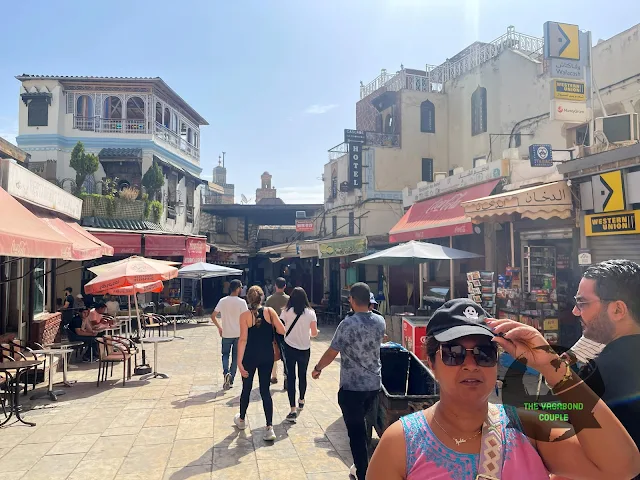 |
| Fes el-Bali immediately behind Bab Boujeloud gate |
Turning around to to look at the east face of the gate, we confirm it is indeed green.
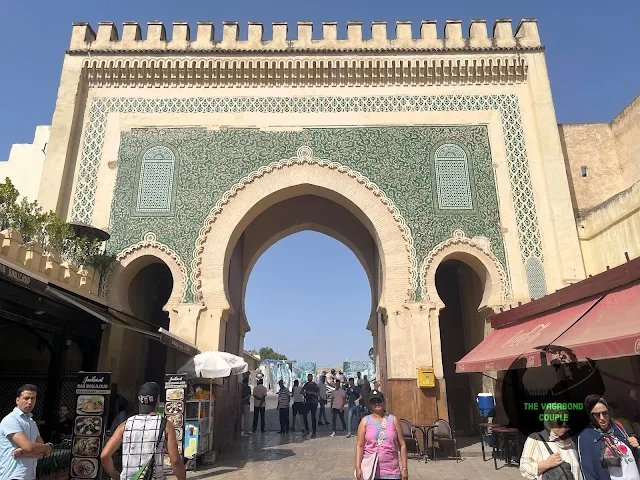 |
| Green (east) side of Bab Bou Jeloud viewed from inside Fes el-Bali |
Dar al-Magana: The Gravity-Powered Water Clock of Fes
Having just entered Fes el-Bali through Bab Bou Jeloud (Blue Gate), we walk through a charming old covered bazaar towards Rue Talaa Kebira.
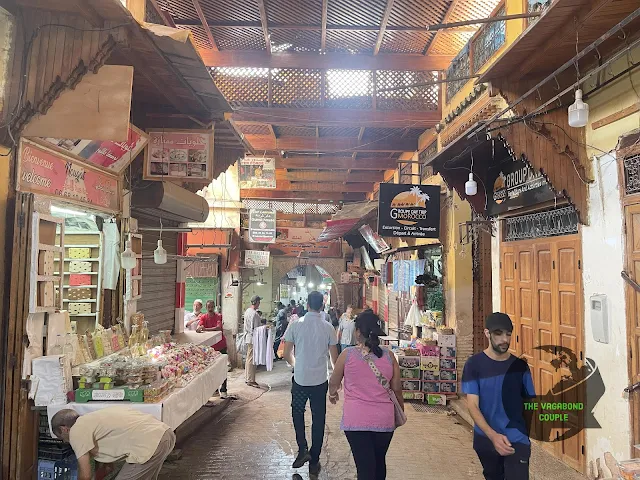 |
| Bab Bou Jeloud gate towards Rue Talaa Kebira |
Rue Talaa Kebira and Rue Talaa Sghira to its south are two streets that cross Fes el-Bali all the way to the east end at Bab Rcif gate which we will reach later. Getting back on either of these two streets is a quick way to get your bearings back after invariably getting lost in Fes el-Bali.
A right on Rue Talaa Kebira and a short walk gets us to the famous gravity (weight) powered water clock of Fes: the Dar al-Magana (House of the Clock). This was commissioned in the 14th century by Sultan Abu Inan Faris of Marinid dynasty as a part of the greater Bou Inania complex.
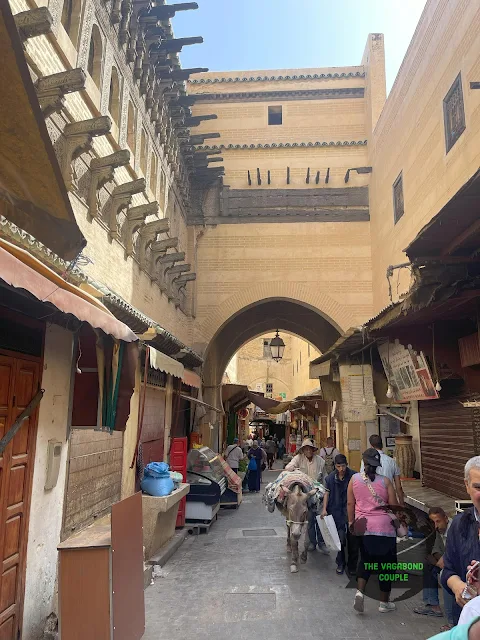 |
| Water Clock of Fes: Dar al-Magana at left |
From the outside, the weight powered water clock of Fes looks like a great work of mechanical and hydraulic engineering. It is also decorated intricately in carved wood and stucco (mix of lime, sand and water).
 |
| Fez Morocco Water Clock, Dar al-Magana, Fes el Bali |
There are twelve square windows near the top of the building. The long rafters below and in between the square windows used to hold a roof up and are not part of the clock. The shorter studs centered below each window have corresponding studs further down below the arched windows. These lower studs used to have brass bowls which are not there now (they were taken away in 2004 as part of an effort to repair the clock).
 |
| Fez Morocco Gravity Powered Water Clock, Dar al-Magana, Fes el Bali |
In an operational state, a door behind each of the square windows at the top would open up in turn and drop a metal ball on the hour every hour. The ball would drop onto the corresponding brass bowl catcher below.
There was some sort of a pusher behind the square windows that would travel left to right between two adjacent windows in exactly one hour. This was powered by a weight on one end and a float on a column of water on the other end. The water was calibrated to flow out and cause the floating weight to drop at a rate that would move the pusher between one window to the next exactly in one hour. The clock would keep working as long as there was water for the float to steadily drop down. Assumedly the water was refilled periodically.
Unfortunately nobody today knows exactly how this clock operates, though there is an ongoing effort to figure it out and get it going again. Here is a picture of the clock from early 20th century with the bowls still in place.
 |
|
Dar al-Magana in the beginning of the last century (Public Domain, Link) |
Bou Inania Madrasa (and Mosque with Minaret)
The stunning Bou Inania Madrasa is right across Dar al-Magana. Unlike Ben Youssef Madrasa in Marrakech which stands as a theological school separately from the mosque and minaret next to it, Bou Inania is a rare madrasa that is also a mosque itself with its own minaret. Friday Islamic prayer congregations held inside Bou Inania make it a religious building. However it remains one the few Moroccan religious monuments that is open to everyone.
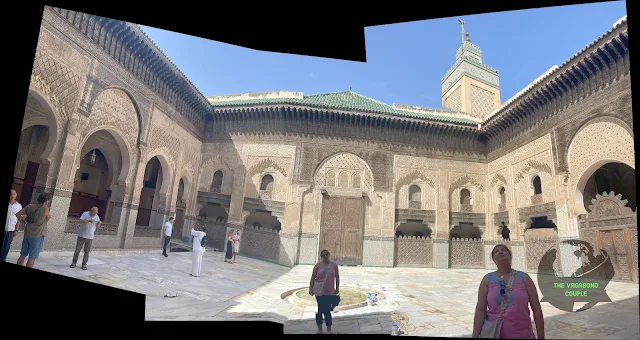 |
| Bou Inania madrasa courtyard (composite) |
The minaret at the northwestern corner of Bou Inania can be seen from Bab Bou Jeloud (the blue gate).
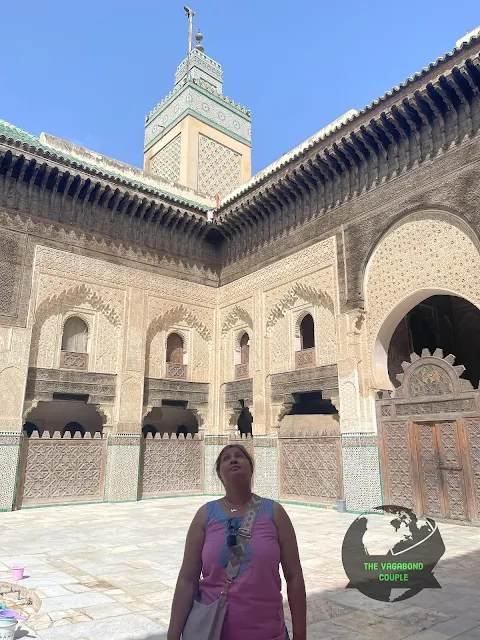 |
| Minaret of Bou Inania madrasa & mosque behind the courtyard |
Bou Inania Madrasa was commissioned in the 14th century by, and named after, Sultan Abu Inan Faris who also commissioned the Dar al-Magana water-clock. It stands as a testament to the architectural and artistic heights reached during rule of the Marinid dynasty.
The madrasa has two entrances: the front door on its northwest side on Rue Talaa Kebira opposite the Dar al-Magana water clock building, and a rear door on its southeast side on Rue Talaa Sghira. We enter the madarasa from the large brass front door with a decorated arch into a grand marble courtyard. There is a low round fountain in the middle of the courtyard which can be used for ablution.
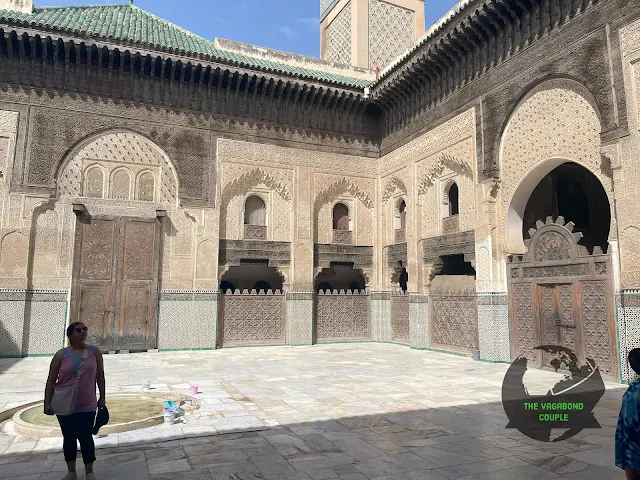 |
| Courtyard of Bou Inania madrasa |
Constructed of cedar wood, brick, stucco and tiles, Bou Inania madrasa is exquisitely sculpted, carved and decorated.
There are beautiful cedar lattice screens between pillars around the courtyard. A passage behind the screens leads into classrooms and common rooms of the madarasa. Stairs at two corners of the passage lead to dorms on the upper floor.
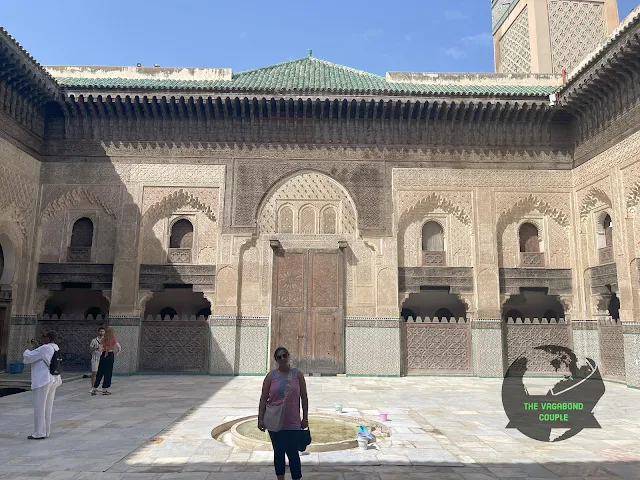 |
| Courtyard of Bou Inania madrasa |
Water flows along a little channel along the prayer hall side of the courtyard. Water from Fes river's el-Lemtiyyin canal is channeled through here. The prayer hall beyond the courtyard is accessed over little bridges at corners.
 |
| Courtyard of Bou Inania madrasa |
The general pattern of the pillars and walls is mosaic of zellij tiles at the bottom, a thin band of sgraffito tiles above it and stucco decoration at the top. There is finely carved wood above the stucco reaching up to the roof.
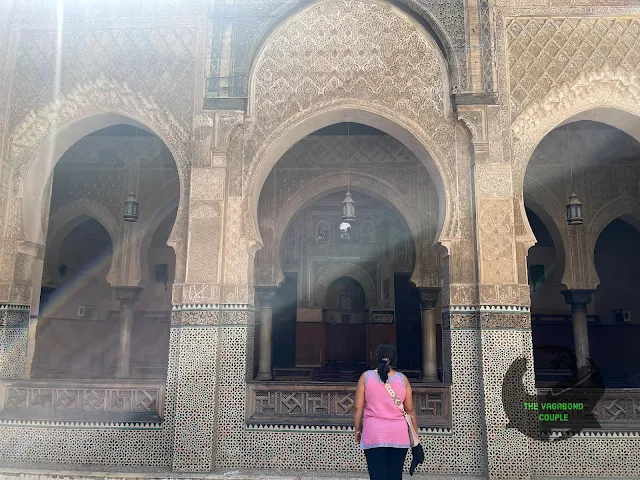 |
| Prayer hall of mosque inside Bou Inania Madrasa |
The prayer hall is the mosque part of the madrasa and only Muslims can cross into it over the water channel. However, the mosque is openly visible from the courtyard giving us an opportunity to appreciate its beauty including gorgeous colored glass windows above and to the sides of the mihrab.
 |
| Prayer hall and mihrab |
The prayer hall has a front and rear part divided by stucco arches on columns made of marble and onyx.
 |
| Prayer hall and mihrab |
Unlike Ben Youssef Madrasa in Marrakech, visitors are limited to pretty much the central courtyard of Bou Inania Madrasa. Though we were not able to walk around the entire building freely, there is enough ancient architectural and artistic wizardry here to keep us agape for a long time.
Exiting Bou Inania through the front door, we get back on Rue Talaa Kebira. Turning south, we go through vibrant bazaars towards Rue Talaa Sghira.
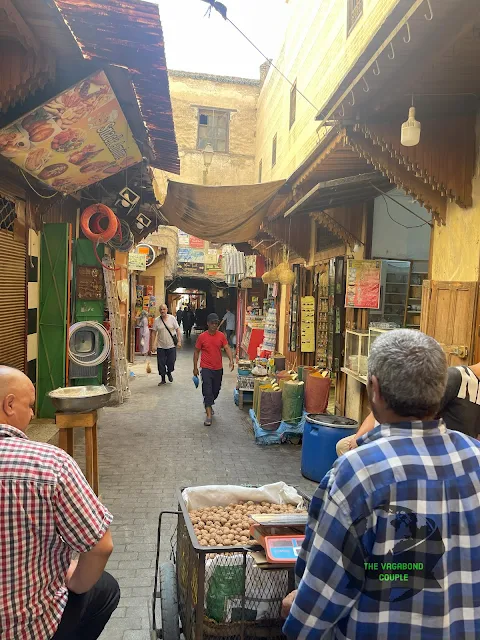 |
| Bazaar between Rue Talaa Kebira and Rue Talaa Sghira east of Madarasa Bou Inania |
 |
| Bazaar between Rue Talaa Kebira and Rue Talaa Sghira east of Madarasa Bou Inania |
Abu al-Hasan Mosque
We head east on Rue Talaa Sghira to Abu al-Hasan Mosque (Abou El Hassane El Marini Mosque). Unable to enter the mosque, we continue east.
 |
| Closed entrance of Abu al-Hasan Mosque at right |
 |
| Closed windows of Abu al-Hasan Mosque |
Talaa Saghira Fountain
The Talaa Saghira Fountain is among Fes el-Bali's most gorgeous mosaic-decorated saqayya, though it does not have a decorated wooden canopy like Nejjarine Fountain in the heart of Medina which we will visit later. Fontaine Talaa Saghira is on Rue Talaa Sghira right after Abu al-Hasan Mosque.
 |
| Talaa Saghira Fountain |
Barbary Fig: Cactus Fruit
We spot a vendor selling barbary fig (prickly pear) from a cart on Rue Talaa Sghira. These are fruits that grow once a year on top of barbary fig cactus plants (Opuntia ficus-indica) which are endemic to Mexico but are also found in desert zones of North Africa. The stems of the plants are also edible. The simplest way to consume these fruits is to peel off the thorny skin and eat the flesh inside, seeds and all. Processed products derived from it include juices, jams, candies and even wine. More information: Healthline.
The Spanish call this fruit "tuna".
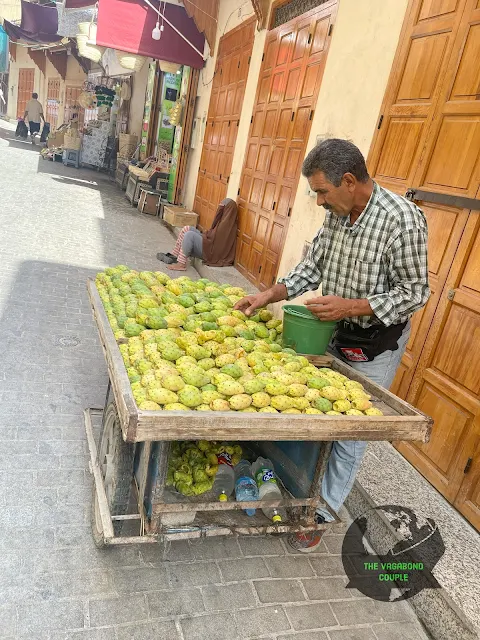 |
| Vendor selling Barbary Fig from a cart on Rue Talaa Sghira |
It is almost 11 o'clock. Although nowhere as hot as we experienced in Marrakech or Erg Chebbi dunes on Sahara Desert, it is hot enough for us to get something to cool down. We get off Rue Talaa Sghira into narrow alleys lined with little shops and buy cold drinks and ice-cream.
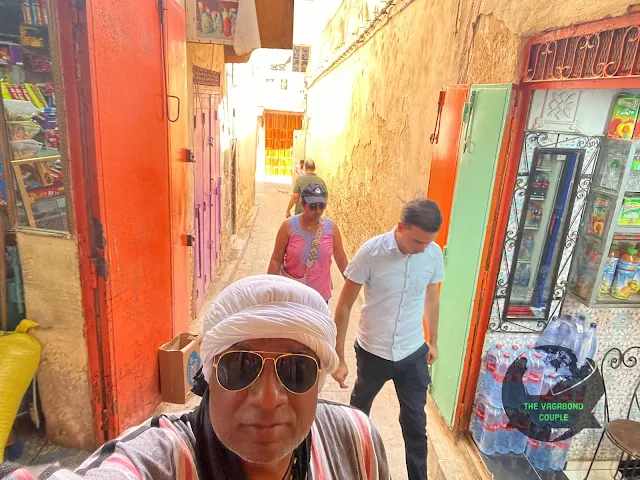 |
| General Store / Mini Market: Cold water, cold drinks and ice-cream |
From Rue Talaa Sghira, we take Derb Zerbtana going southwest to check out the fancy entrance of the five-star Riad Fes Relais & Châteaux hotel that is about 10 times more expensive than the beautiful dar we lodged at.
On towards Bab Rcif
We continue east on Derb Sefli towards Rue Sidi Mohammed Belhaj, crossing Muhammad Al-Qura School on the way.
 |
| Muhammad Al-Qura School |
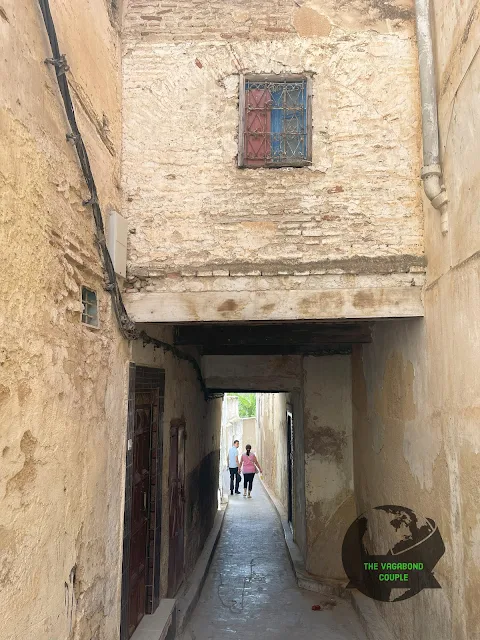 |
| Eastbound Derb Sefli towards Rue Sidi Mohammed Belhaj |
Taking a right on southbound Rue Sidi Mohammed Belhaj, we walk towards the next intersection with Rue Seyaje (Dar Siaj) on which we make a left to walk east towards Hotel Fes. The saqaya of Siaj fountain is on this lane.
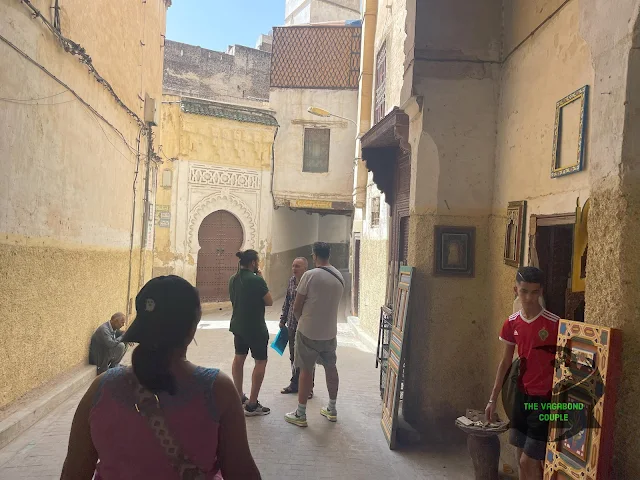 |
| Rue Sidi Mohamed Belhaj |
 |
| Rue Seyaje |
Dar Siaj becomes more interesting as it rapidly slopes downwards as we approach the Abderrahim antique store where the dar ends and leads into charmingly narrow paths between houses.
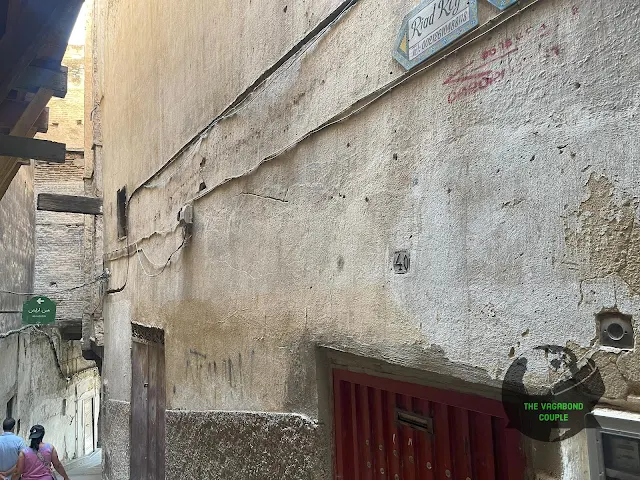 |
| Dar Siaj |
We take the alley south between houses at the end of Dar Siaj. This is one of the paths not present in google maps. We later edited google maps and submitted requests for updates to google.
We continue to descend rapidly along this unmapped path all the way to Derb Rechm at Riad Laayoun.
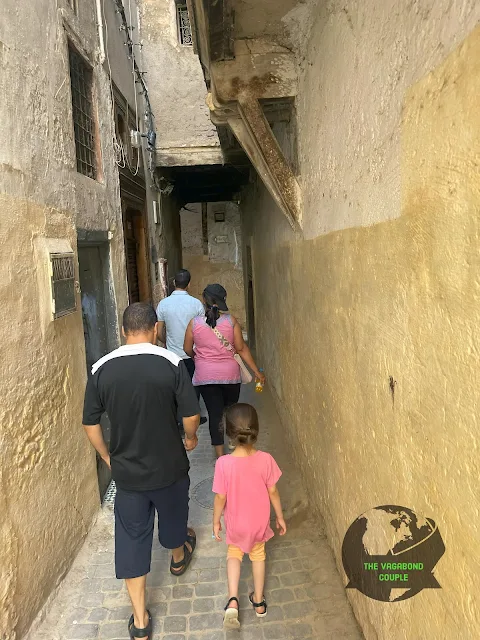 |
| Unmapped alleys from Dar Siaj to Derb Rechm, Fes |
The upper and lower knockers on ancient Moroccan doors
The doors to grand old houses in old Morocco had two metal knockers at different heights. Men knocking at the door would use the upper knocker and women would use the lower one. The sound of the two knockers were different so that people inside would know the gender of the person knocking. The idea was if a woman knocked on a door and no women were inside, the men wouldn't open the door.
In modern Morocco, there are security cameras over traditional entrances.
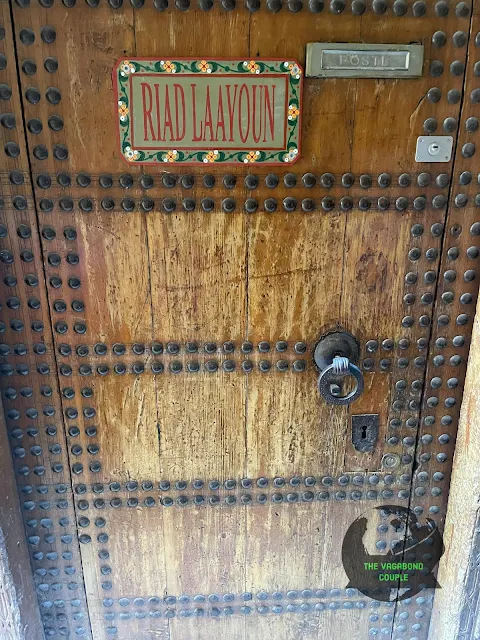 |
| Upper and lower knockers on door of traditional Moroccan house |
On to Bab Rcif gate and Place R'cif square
We continue our pedestrian journey east on Derb Rechm and then south on Derb Lamkouass Laayoun Rcif. We get on Rue Rahbat Tben and continue into bazaars eventually taking Bulevard Ben Mohammed El Alaoui northwest to Bab Rcif gate and Place R'cif square.
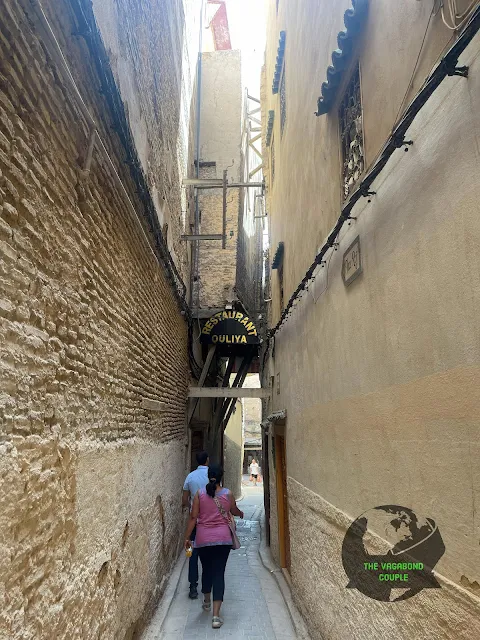 |
| Derb Rechm towards Derb Lamkouass Laayoun Rcif |
 |
| Rue Rahbat Tben towards Ben Mohammed El Alaoui Boulevard |
The markets here seem to be more of daily household shopping type, less full of souvenir and gift shops than the western side of the medina. We see a lot of local people here purchasing fruits, vegetables, fish and meat (including camel meat) essential for running household kitchens.
 |
| Bazaars on Rue Rahbat Tben towards Bab Rcif gate |
Bab Rcif gate and Place R'cif square
We are now at Place Rcif, the open central square or plaza at the east end of Medina of Fez. The looming Bab Rcif gate on the south side of the square is beautifully decorated. Coming in from outside of the medeina in the south, Ben Mohammed El Alaoui Boulevard goes under the gate and expands into the large Place Rcif square north of the gate inside Fes el-Bali. This area of this gate is a vibrant busy place with more local folks than tourists going about their businesses around the square and bazaars in the alleys of Fes el-Bali beyond the square.
The Bab Rcif gate is also a new 20th century gate built by the French. We wonder if its massive doors, like those of its twin Bab Bou Jeloud on the west of Fes el-Bali, can also be locked only from the outside.
At this point we have walked across numerous alleys all the way from Bab Boujloud gate on the west to Bab R'cif gate on the east of Fes el-Bali. It seems a long way, but really the aerial distance between the two gates is just short of one mile (3,422.99 ft, 1.04 km).
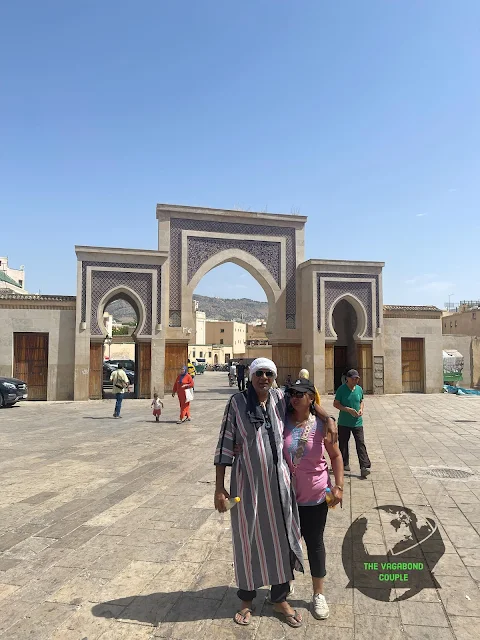 |
| Bab Rcif gate with Place R'cif square behind |
R'cif Mosque
The tall minaret of R'cif Mosque looms over the western side of Place R'cif square. The 18th-century mosque was commissioned by Sultan Moulay Slimane of Alaouite dynasty. Along with al-Qarawiyyin Mosque, R'cif Mosque was a central gathering place for protestors during the 1937 riots against French occupation.
Walking north from Place R'cif plaza, we reach the eastern bank of Bou Khrareb river. We cross over a bridge to Tarrafine shopping mall and turn north into Souk Es Sabbaghine: Souk of the Dyers. This market traditionally specializes in color dying garments and clothing made of various materials including silk, wool and cotton.
 |
| Souk Sabbaghine |
The Fontaine Sabaghine (Sabaghine Fountain) provides water for dying clothes. Water is first collected in buckets by the dyers.
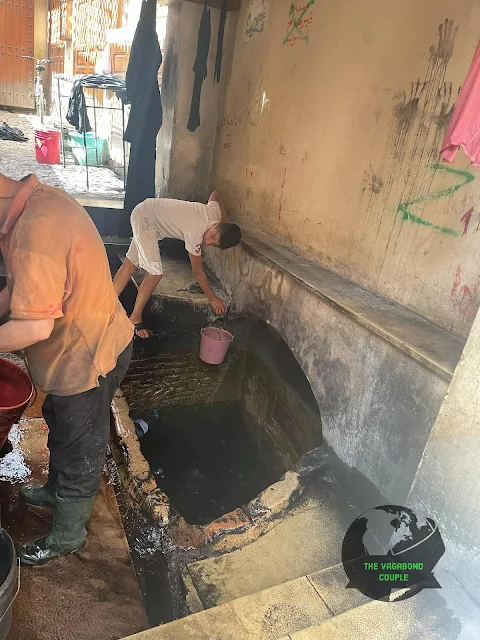 |
| Sabaghine Fountain: Collection water in buckets for dying |
The collected water is then heated in metal buckets over fire. Dye is added to the water and clothes immersed and drenched in the metal bucket. Colored clothes come out of steaming metal buckets.
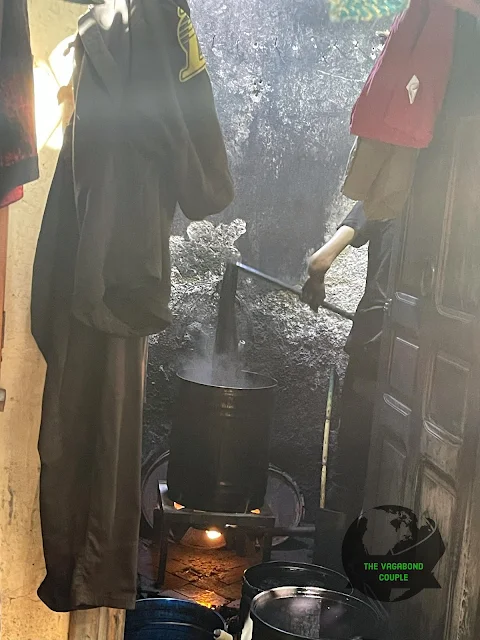 |
| Dying of clothes at Souk Sabbaghine |
We are told it is entirely possible to re-dye garments in a different color. The dyers here can take existing dye off clothes and put a different dye on, making clothes look new.
Freshly dyed clothes, balls of dyed wool and lengths of dyed yarn are on sale as well in the souk.
 |
| Dyed clothes, wool and yarn for sale at Souk Sabbaghine |
Oued Bou Khrareb: Khrachfiyine Pont
Souk Sabbaghine lies along the west side of Oued Bou Khrareb which, along with Oued Bou Regreg, is a source of the ancient Oued Al-Jawahir Fes canal and reservoir based water supply and irrigation system. The water system is also called the Fes River.
Khrachfiyine Pont is a great viewpoint overlooking Oued Bou Khrareb from a bridge next to Souk Sabbaghine.
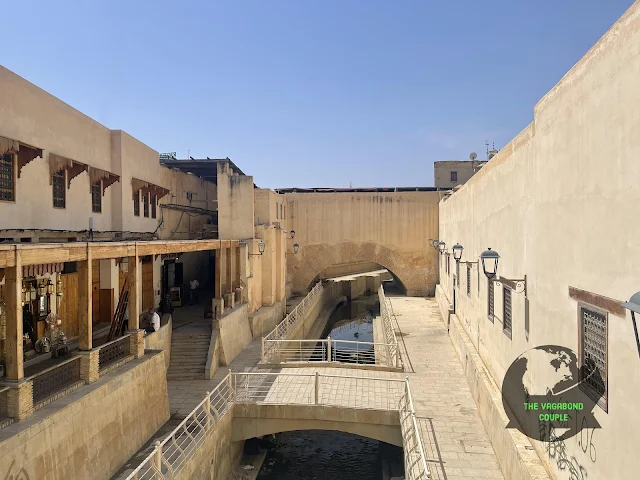 |
| View of Oued Bou Khrareb looking north from Khrachfiyine Pont bridge |
 |
| View of Oued Bou Khrareb river looking south from Khrachfiyine Pont bridge |
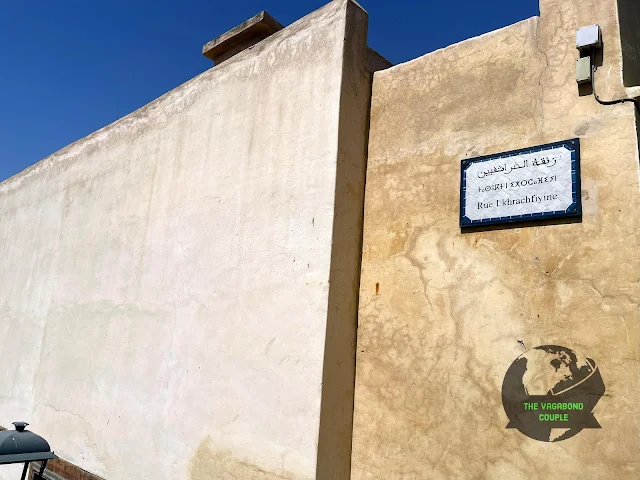 |
| Wall and street sign across on the east side of Khrachfiyine Pont bridge |
From Souk Sabbaghine, we head north on Rue Seffarine. Implausibly Fes el-Bali is becoming even more glamorous as we walk through the bazaars and past the historic Seffarine Hammam (bathhouse) towards Seffarine Square neighborhood of coppersmiths and metalware.
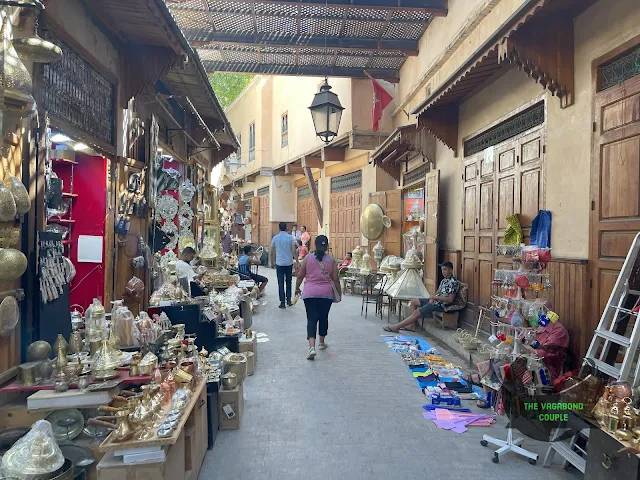 |
| Rue Seffarine towards Place Seffarine |
Place Seffarine
Seffarine continues to be the souq of coppersmiths, bronze smiths and metalworkers in general from at least the middle ages. Traditional techniques of their metalcraft have been handed down over many generations.
Tools and utensils made of brass, copper, bronze, zinc, nickel and silver finely crafted by metalsmiths using hammers, lathes, rolling mills and polishers, and decorated by artisans, are still produced and sold here. Metal products built and sold here for all kinds of budgets are used daily by Moroccan families. The items include pots, pans, buckets, incense burners, trays, teapots, tea and sugar boxes, footed strainers, kettles, couscous steamers, samovars and so on. There also are richly decorated vessels for special occasions.
 |
| Place Seffarine visitor information board on Rue Seffarine |
In the traditional way of work here, production lines are organized consisting of workers passing increasingly complete products from one to the next in a well-defined skill-based hierarchy.
 |
| Building with Place Seffarine street sign |
We will soon see entire shops overflowing with amazing metalware from Seffarine. In the meanwhile, we head up north on Dar Boutouille past Place Seffarine towards the Mosque and University of al-Qarawiyyin.
 |
| Dar Boutouille towards Alqarawiyyeen Mosque and University |
Mosque and University of al-Qarawiyyin
Kairaouine Mosque, University and Library
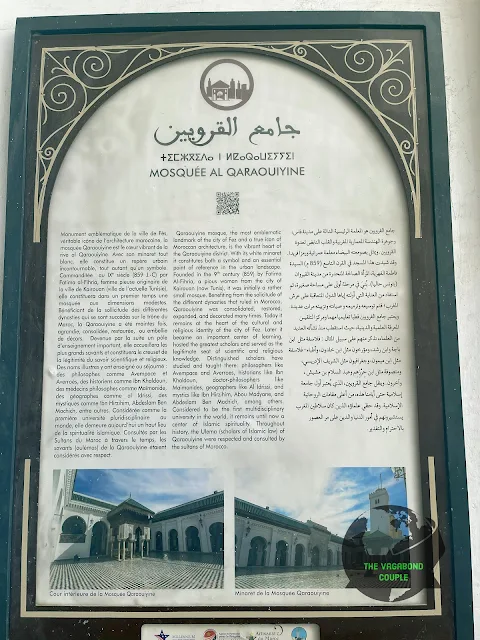 |
| Al-Karaouine Visitor Information |
The University of Al Quaraouiyine in Fez is the world's oldest functional university recorded as such by both UNESCO and the Guiness Book of World Records.
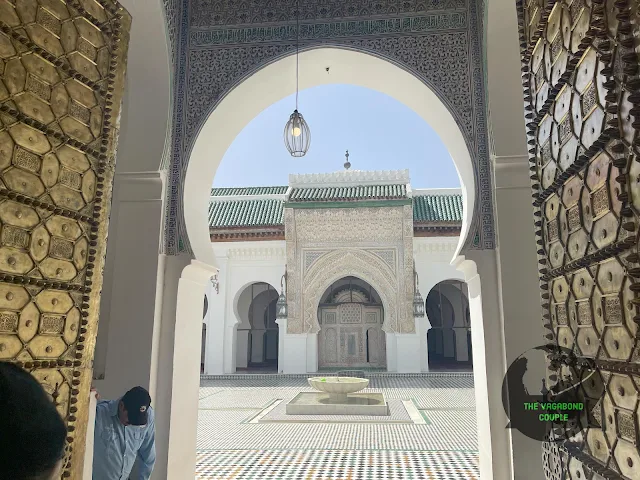 |
| View of al-Qarawiyyin mosque and university from entrance doors |
The 9th century Mosque and University of al-Qarawiyyin is among the greatest of monuments, and the cultural and religious heart, of the Medina of Fez.
A modest mosque was initially founded at the site in 857 CE by a holy woman named Fatima al-Fihriya from Kairouan, Tunisia. Subsequently restored, expanded and decorated repeatedly by Sultans of various dynasties, the mosque with its iconic white minaret is a shining testament to the skills of Moroccan architects and artisans.
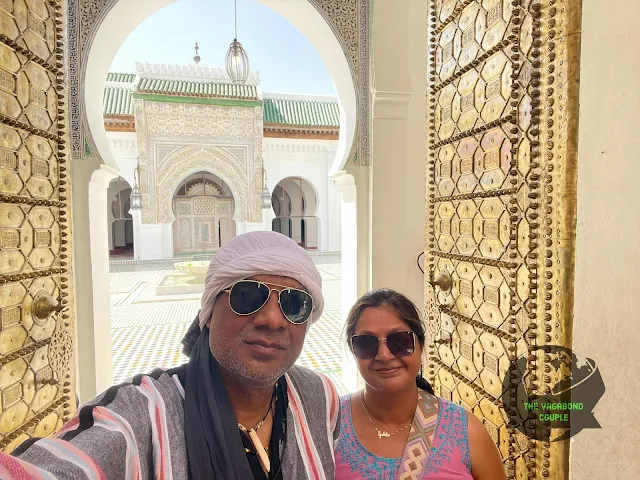 |
| View of al-Qarawiyyin mosque and university from entrance doors |
Al-Qarawiyyin developed into an illustrious institution of learning and teaching over the years from its founding almost 1,200 years ago. Great scholars pursued science, mathematics, grammar, medicine, philosophy and Islamic studies here. It was the first university to issue academic degrees to students according to levels of achievement.
 |
| Ceiling and wall decorations of Alqarawiyyeen entrance doors |
Al Quaraouiyine continues to function today as a revered theological school. It was formally inducted into modern Moroccan state university system in 1963 and subsequently officially registered as "University of Al Quaraouiyine". Around 8,500 pupils currently pursue Islamic studies and Arabic language and literature. They now have a campus in California, United States of America as well.
As we continue north into Rue Rhabt L'Qais past Al Attarine Madrasa, we meet our old friend Rue Talaa Kebira that meets here all the way from Bab Bou Jeloud gate where we started on the west end of Fes el Bali.
We briefly stop at the beautiful and popular shopping place of Art Gallery Attarine and its adjacent Gift shop el Larbi Fez.
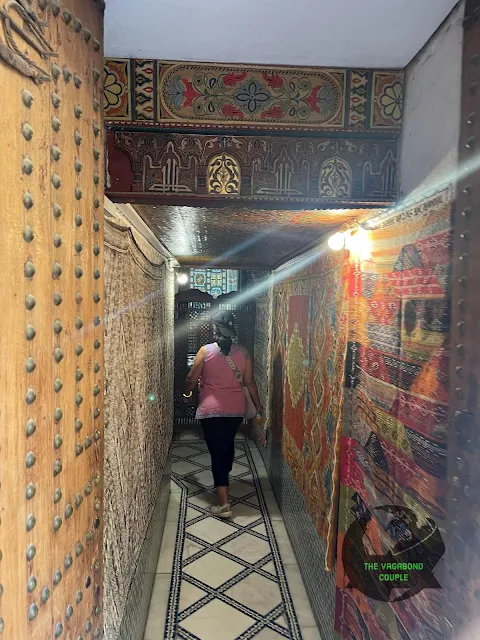 |
| Art Gallery Attarine |
There are awesome stores in this neighborhood selling traditional Moroccan collectibles, souvenirs and useful items including Berber argan and herbal extracts, spices, cosmetics, perfumes, carpets, rugs, garments and so on as we continue north on Rue Rhabt L'Qais past Fontaine Sidi Ahmed Tijani, and further north on Rue Derb Blida.
In Islamic architectural tradition of nondescript doors into spectacular riads, the entrances to these stores are lacklustre but the insides are incredibly huge with multiple beautifully decorated, displayed and stocked rooms and selling spaces.
We have been to the villages in the Atlas mountains where the products originate from (see Marrakech: Daughter of the Desert and Atlas Mountains | Medina, Jemaa el-Fna Square, Atlas Mountains, Ourika, Berber Village to Sti Fadma Falls and The Great Sahara of Morocco: Canyons of Todra Gorge, Farm on Tinghir Oasis, Amazigh Carpets and Riding Camels Over Merzouga High Erg Chebbi Dunes to Desert Camp Deep in Ocean of Orange Sand) and have skip actually purchasing anything here.
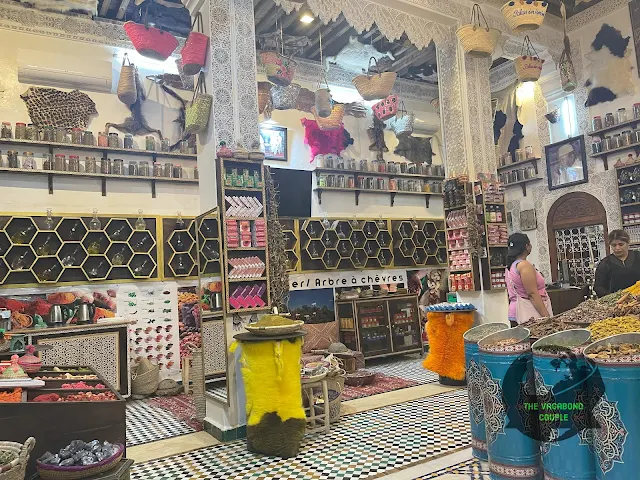 |
| Berber Argan Oil, Herbal Extracts, Perfumes, Medicines and Cosmetics Store on Rue Rhabt L'Qais |
 |
| Berber Carpet and Rugs Store on Rue Rhabt L'Qais |
 |
| Traditional Moroccan jewelry, accessories and clothing store on Rue Derb Blida |
Eventually we head back south to Al Attarine Madrasa where Rue Talaa Kebira meets Rue Rhabt L'Qais.
We get into the markets on westbound Rue Talaa Kebira which is also called Rue al-Attarine around this area.
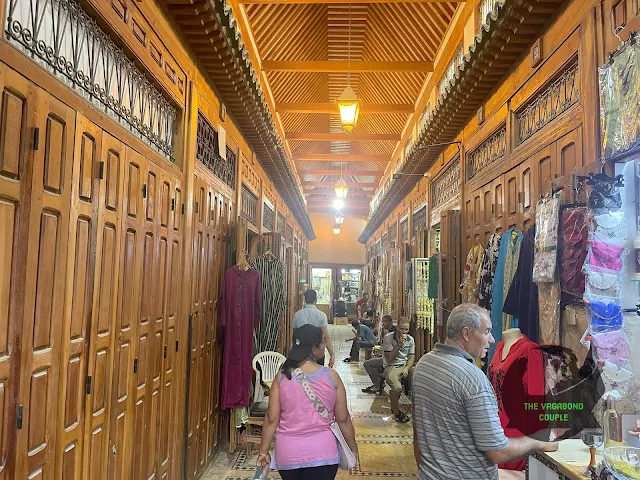 |
| Rue Talaa Kebira / Rue al Attarine |
Mausoleum of Moulay Idriss II
Zaouia Moulay Idriss II
Moulay Idris II was the ruler of Morocco from 807 to 828 CE. He moved the capital from Volubilis (an abandoned Berber-Roman city near Meknes) to Fez in 809 CE and is considered the founder of the city of Fes.
His mausoleum Zaouia Moulay Idriss II is among Morocco's holiest of shrines. The monument features a minaret and a mausoleum chamber with a large pyramidal roof.
Turning south from Rue Talaa Kebira into Souk Sebbat Kissariat el-Kifah, we stop at one of the magnificent doors to the tomb complex of Moulay Idriss II. This door of the zawiya (Islamic shrine) are bolted closed.
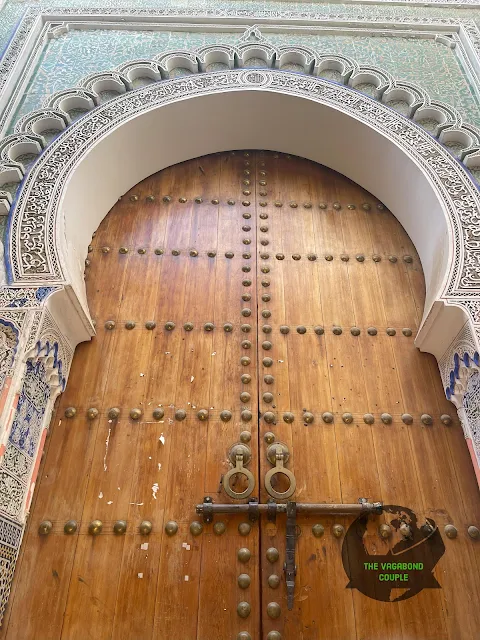 |
| A door to mausoleum of Moulay Idriss II (Zaouia Moulay Idriss II) |
There is a well decorated hanging wall in front of the complex reaching down from the top leaving the bottom open. The opening below is roughly the height of an average person.
Walls like this barricading the upper part of entrances were traditionally used to enforce entry of only those on foot as against riding a horse or a camel. In other words, animals or people riding animals were not allowed access to the door behind.
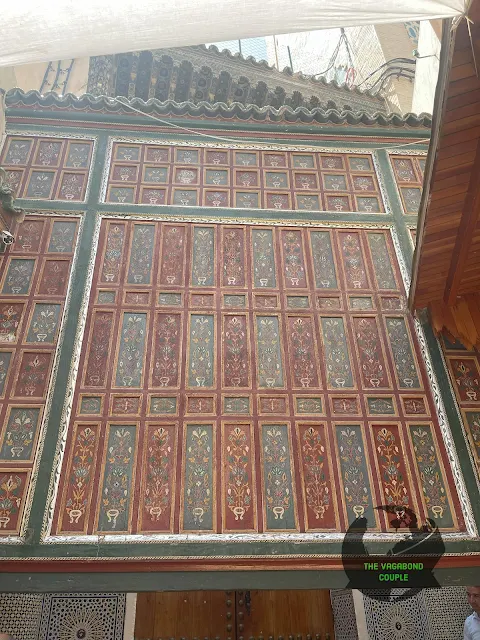 |
| Barricade to stop animals from entering Mausoleum of Moulay Idriss II |
We go around Zaouia Moulay Idriss II marveling at other spectacular doors which are also closed.
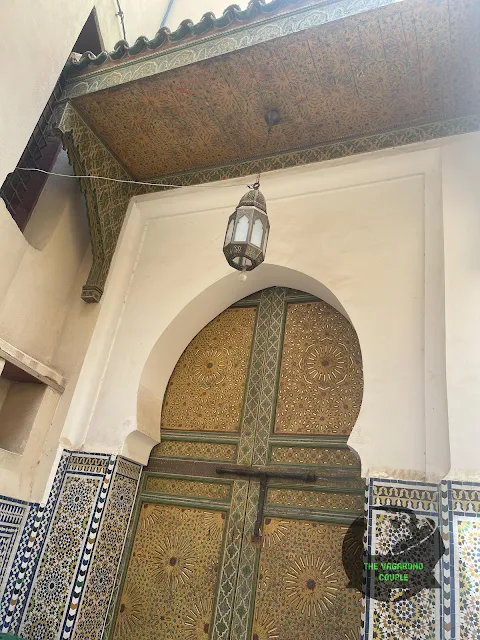 |
| Zaouia Moulay Idriss II |
At last we find the main entrance door to the tomb. We take a look from outside since non-Muslims are not allowed in. From the inside it looks like this and this.
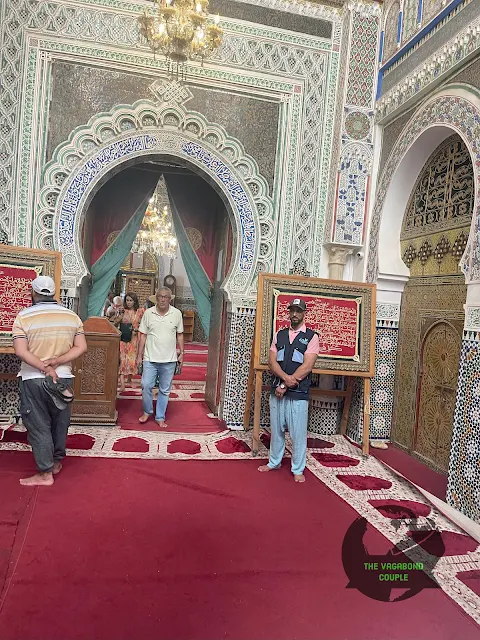 |
| Entrance of Mausoleum of Moulay Idriss II |
We head west towards Derb Sidi Moussa and one of the world's best preserved caravanserais om the ancient silk road.
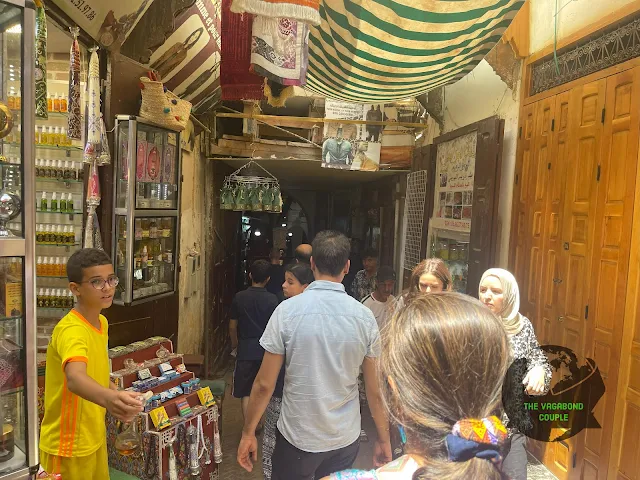 |
| From Mausoleum of Moulay Idriss II towards Derb Sidi Moussa and Place Nejjarine |
Nejjarine Fountain
Fountain in the Heart of Medina of Fez
This 18th century fountain in Al-Najjarin square (Place Nejjarine) is especially notable for its canopy and gorgeous decoration of wood and stucco with exquisite zellige mosaic tile work around the water spout. This is a functional saqayya with people still using water from it.
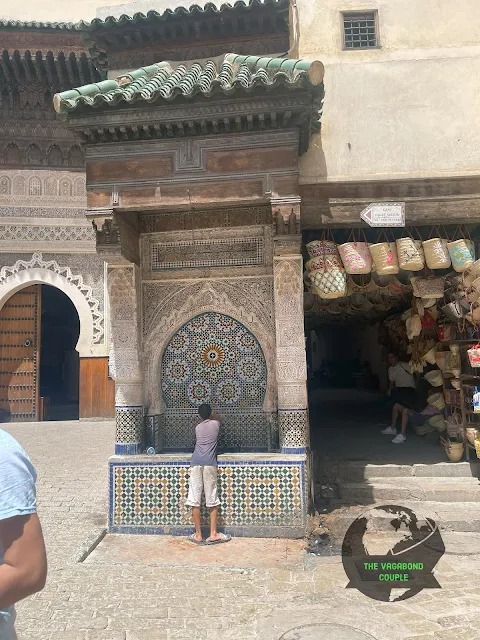 |
| Najjarine Fountain |
Funduq al-Nejjarine: A Caravanserai on the Ancient Silk Road
Nejjarine Museum of Wooden Arts & Crafts
Fes was a mega trade crossroad on the ancient silk road. There were numerous caravanserais in Fes. A few have been renovated and restored.
One of the perfectly preserved caravanserais of the the ancient silk road in the world, the 14th century Funduq al Najjarin in Fes el-Bali in Fez Medina has been on our bucket list for a long time.
The spectacular entrance to the fonduk is located next to Nejjarine Fountain. A carved cedar wood canopy hangs over the magnificent entrance door with tile and carved stucco decoration around it.
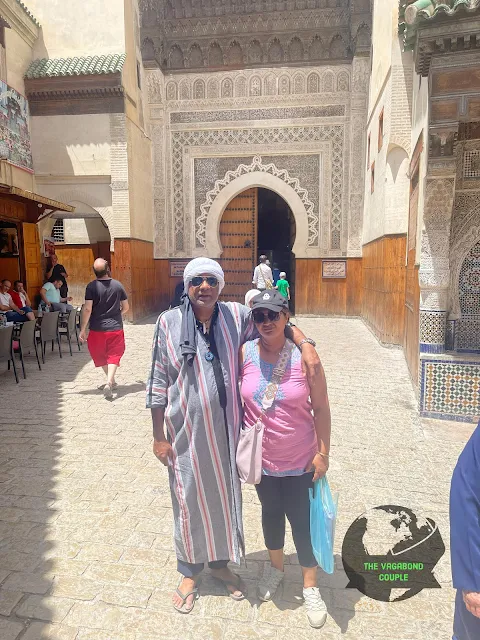 |
| Entrance to Nejjarine Funduq behind Nejjarine Fountain, Place Nejjarine |
A Funduq (also called "Khan") is an inn, especially for traders and travelers on the medieval silk road. Since a camel can cover roughly 100 miles in a day, the entire silk road system had at least one fondouk every 100 miles offering travelers and their animals a place to clean up, feed, rest and recuperate. Most also offered storage spaces for goods carried by traders.
 |
| Nejjarine Funduq |
A funduq typically had a central courtyard surrounded by two or more floors with rooms (Nejjarine funduq has three floors). There would be stables, and food, water and services for camels and horses, on the main floor or sometime at a lower level below the main floor.
 |
| Main and two upper floors of Fondouk el-Nejjarine caravanserai |
Nejjarine funduq is now a private museum called Al-Najjarine Museum for Wood Arts and Crafts run by Muhammad Karim Lamrani Foundation for the Carpenters Group.
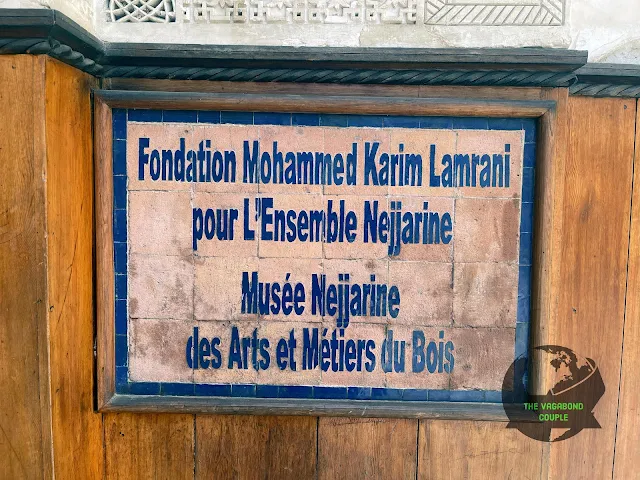
 |
| Al-Najjarine Museum for Wood Arts and Crafts in Najjarine Fandouq |
Visitors can purchase tickets to enter the caravanserai turned museum which has numerous exhibits in the three floors of rooms around the courtyard. Traditional Moroccan wooden artefacts from the 14th to the 18th centuries including furniture, chests, doors and building components as well as tools and techniques used in making them are on display.
 |
| A room with exhibits at Al-Najjarine Museum for Wood Arts & Crafts, Fandouq al-Najjarine |
The sophistication of Moroccan woodwork is on full display, though photography of exhibits is not allowed.
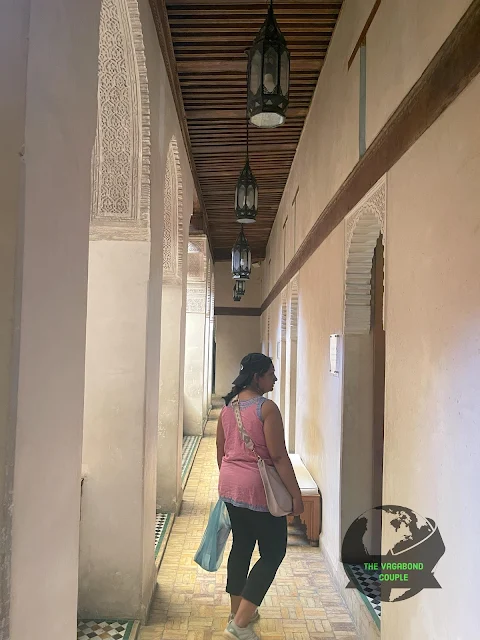 |
| Corridor with rooms, Nejjarine Funduq |
The terrace of Fondouk el-Nejjarine offers great views of Fes el-Bali inside the old walled city Medina of Fez. There is a cafe with seating on the terrace but we found it closed, perhaps another toll taken by the pandemic. The minaret and pyramidal roof of Zaouia Moulay Idriss II is clearly visible from here.
 |
| Minaret and roof of Mausoleum of Moulay Idriss II seen from terrace of Fondouk el-Nejjarine |
 |
| Views of Fes el-Bali from terrace of Funduq al-Nejjarine |
We leave the caravanserai with lingering wonderous awe and head west back along bazaars along Rue Talaa Kebira.
 |
| Rue Talaa Kebira |
We cross Bellagine souk, the market of locksmiths making Farkha wooden and iron locks for household doors, and Qbaqab wooden clogs (elevated slippers) for use by Fassis (people of Fez) in Moorish baths and Hammams. Like earlier Roman thermae baths (See our Egypt story), Moorish baths had trios of rooms of hot, warm and cold baths with the floor and water heated by ovens under them or hypocausts. Bathers wore qbaqabs to avoid burning their feet on hot floors.
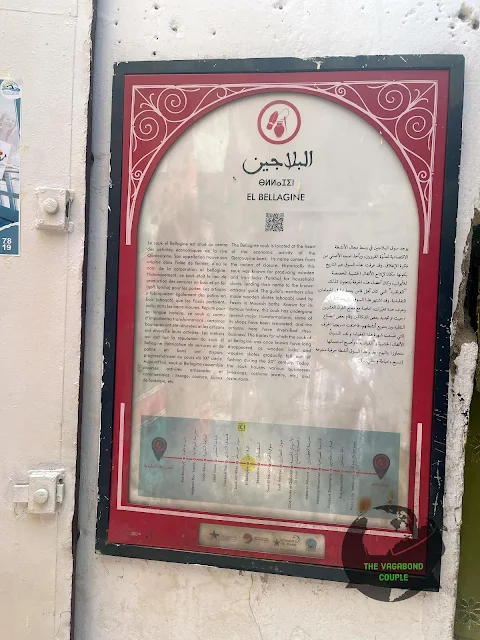 |
| Bellagine souk visitor sign board |
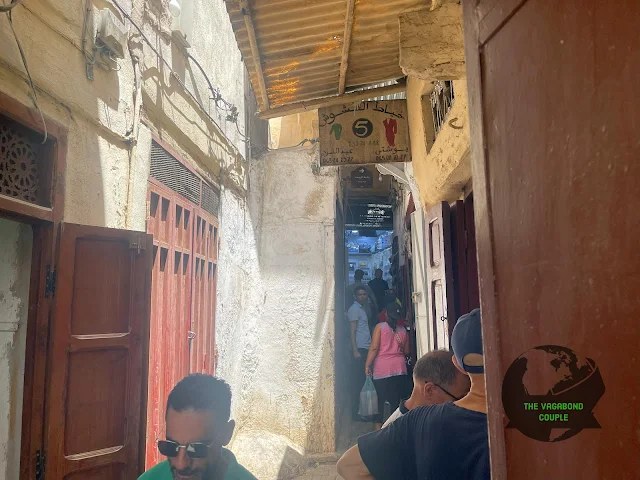 |
| Rue Talaa Kebira |
We stop at one of the numerous gift shops along the way on Rue Talaa Kebira. These shops are stuffed with glittering lamps, lanterns, jewelry, utensils and decorative items.
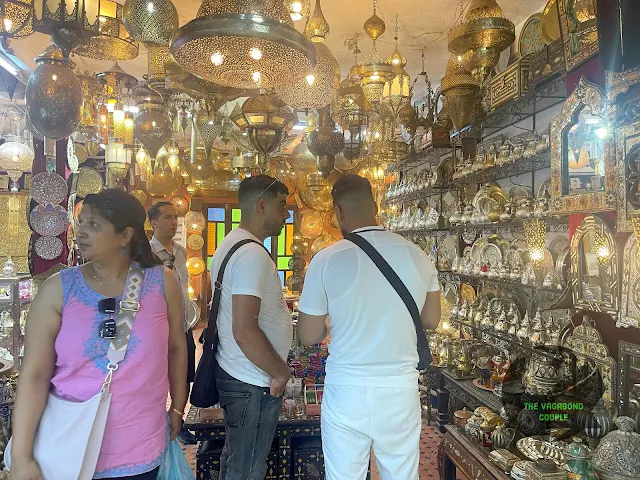 |
| Bazaar along Rue Talaa Kebira |
It is past lunch time when we head back west on Rue Talaa Kebira. The narrow alley of Derb Dermami Nejjarine north from Talaa Kebira leads us to the huge and beautiful Nejjarine Restaurant. Once again, the entrance is not an indication of the grandeur inside of the restaurant.
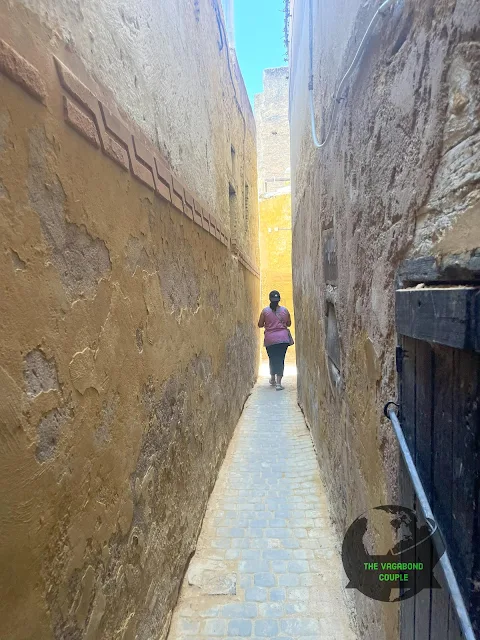 |
| Derb Dermami Nejjarine |
 |
| Nejjarine Restaurant |
We are offered fruits and bread for starters. This consists of 13 different plates each with a different type of fruit preparation along with a basket of bread. The main course and the dessert are equally lavish.
We are once again surprised at the price of the three-course meal here. It costs exactly the same - around US$13 in Moroccan Dirhams - as a three-course lunch in the middle of the Sahara. We wonder if the prices are fixed by the administration.
 |
| Fruits for starters at Nejjarine Restaurant |
B'eslama Fes el-Bali
Till we meet again
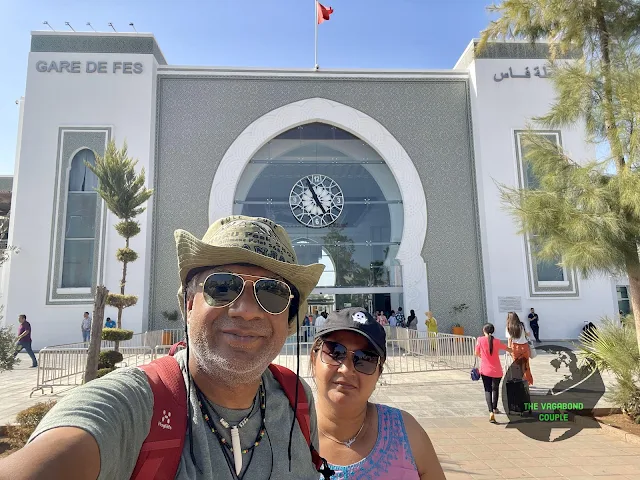 |
| Gare de Fes |
 |
| Gare de Fes - Fes railway station |
We return to our riad after the super-sumptuous lunch, check out and hire a cart to take us back to the taxi stand on Rue Sidi el-Khayat outside of Bab Boujloud gate. We get to Gare de Fes train station to take a ONCF train to our next destination of Casablanca. The station is beautiful.
Curiously, the Indian Hindi language edition of Tintin in Congo is stuck on the wall of a cafe and smoothie stall at the Fez train station.
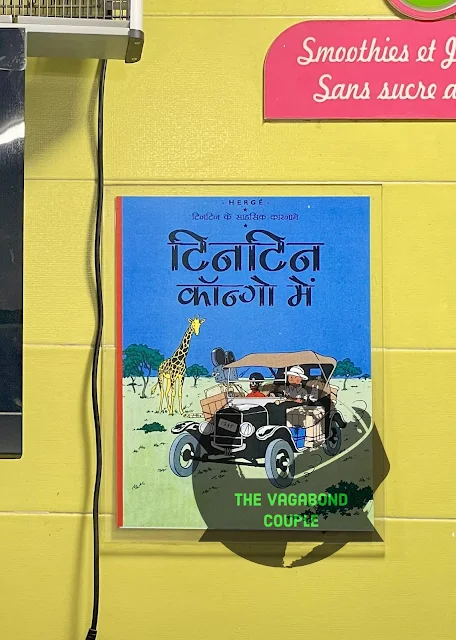 |
| Hindi edition of Tintin in Congo at Fes, Morocco Train Station |
 |
| Departure board at Fez, Morocco Train Station |
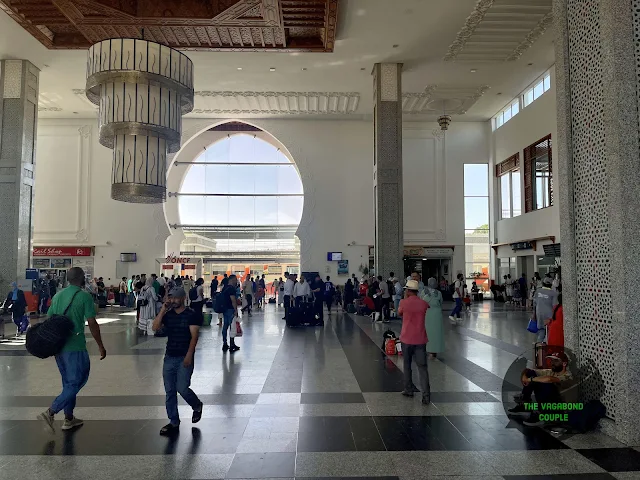 |
| Main hall inside Gare de Fes - Fez, Morocco Train Station |
 |
| Train to Casablanca at platform, Fes Train Station |
We cross Rabat on the train and head to Casablanca. That photo story is at "Casablanca - The White House (Dar al-Bayda)".


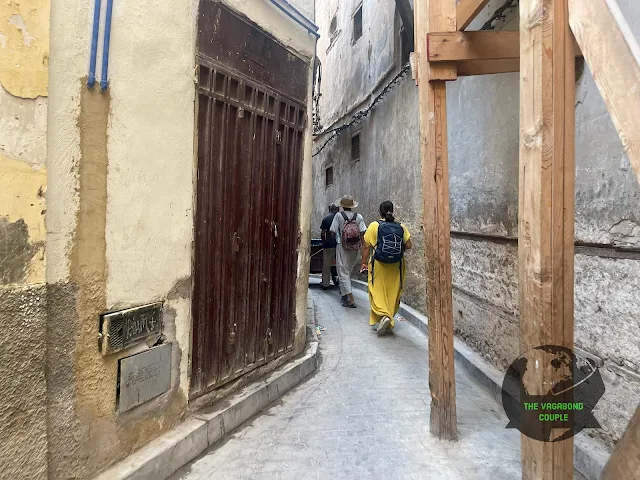
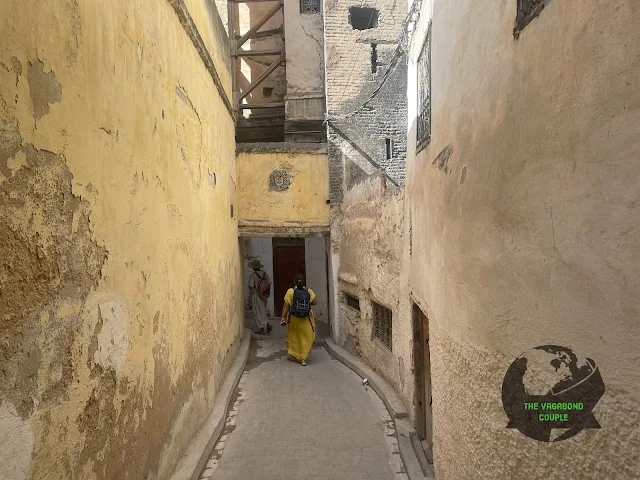
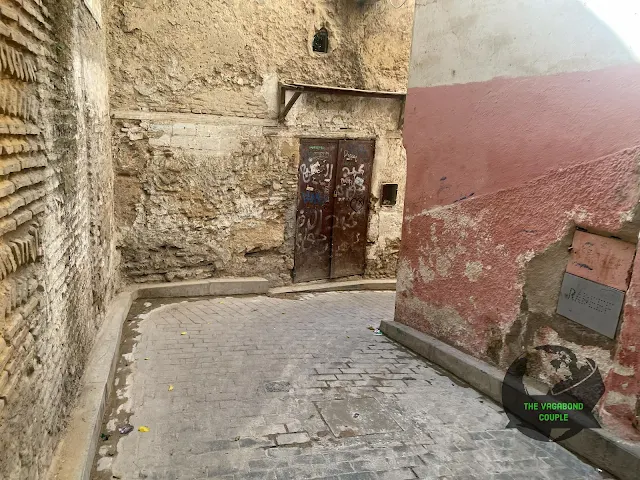
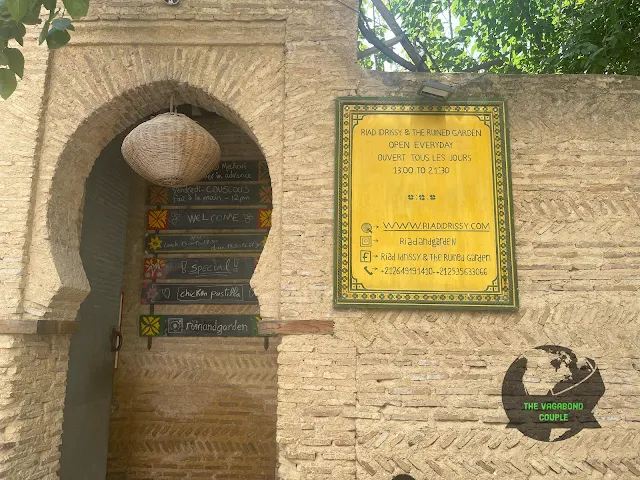
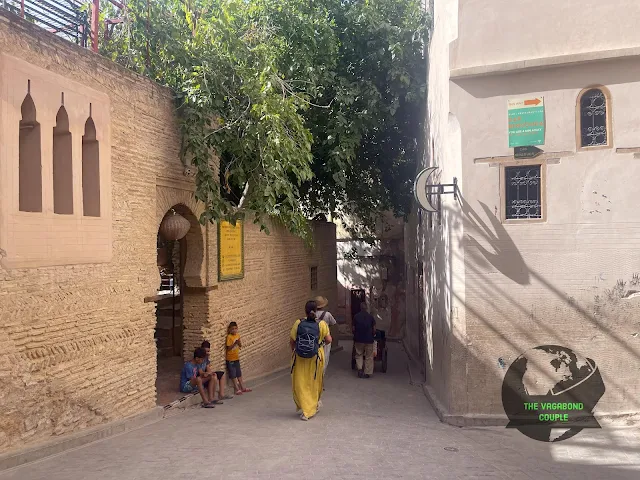
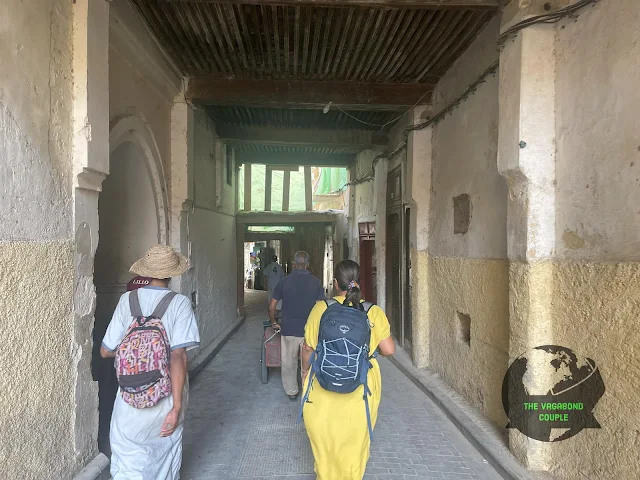
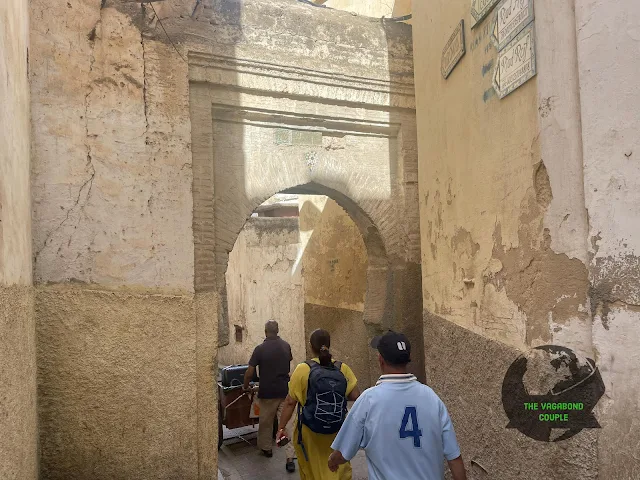
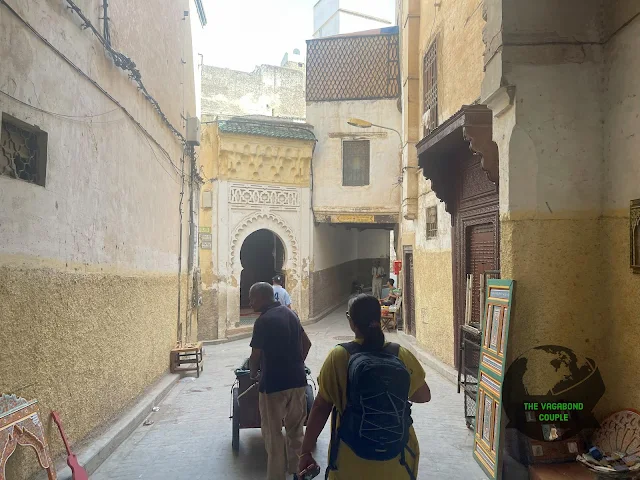


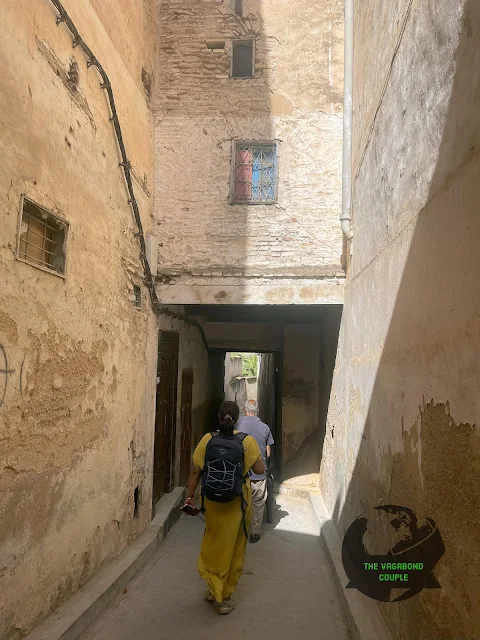
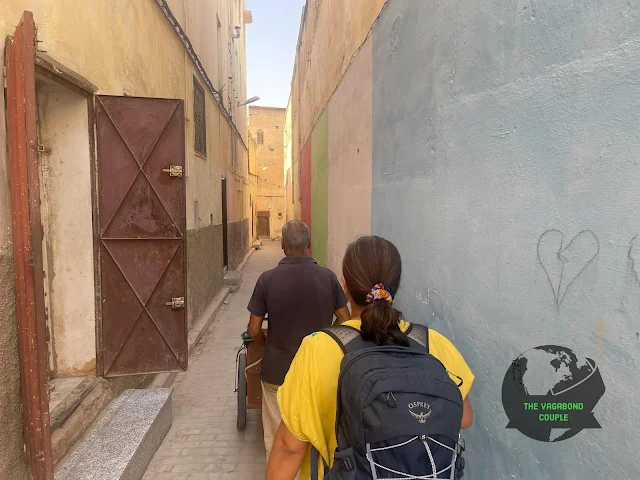

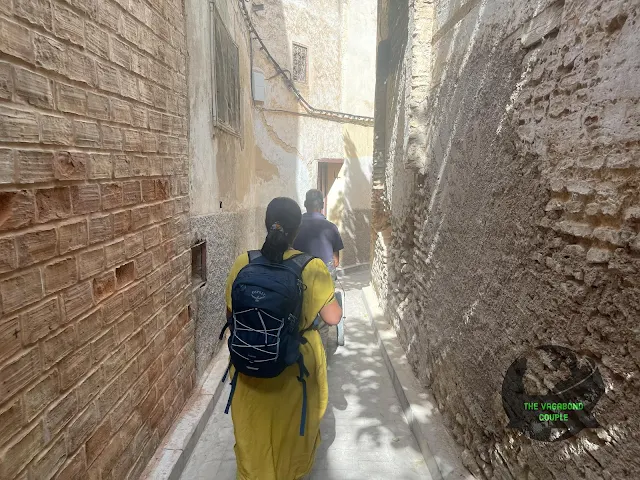
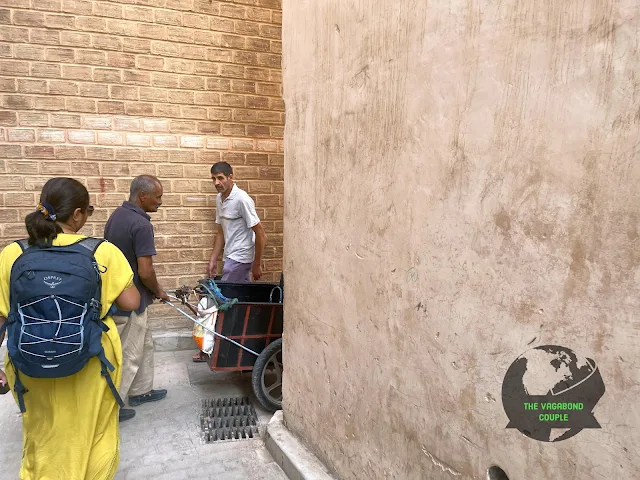
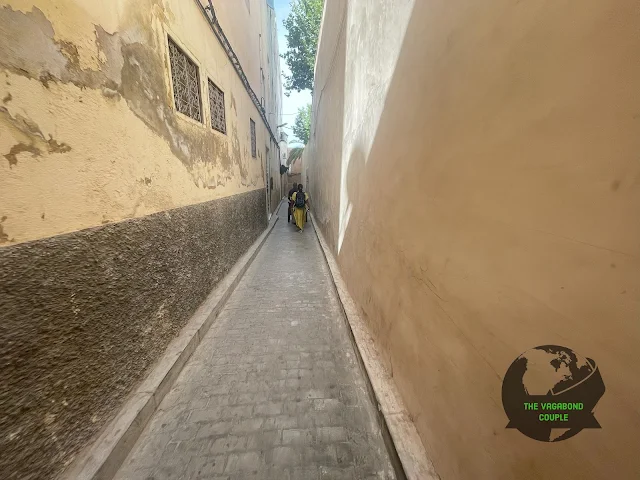



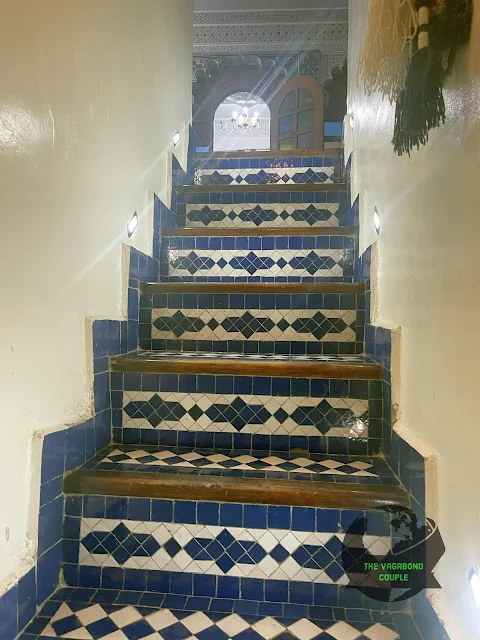
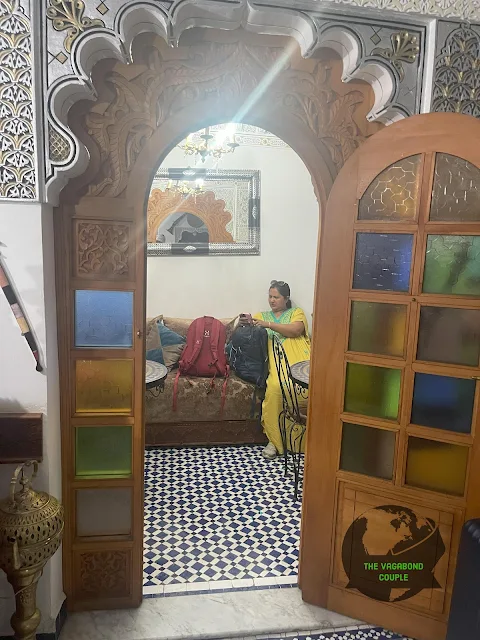
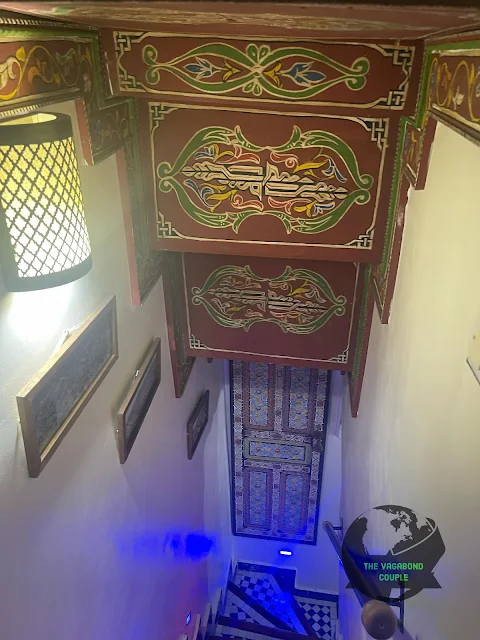


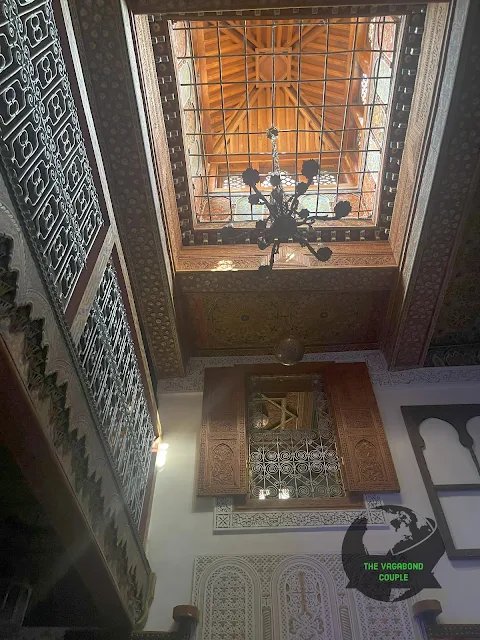

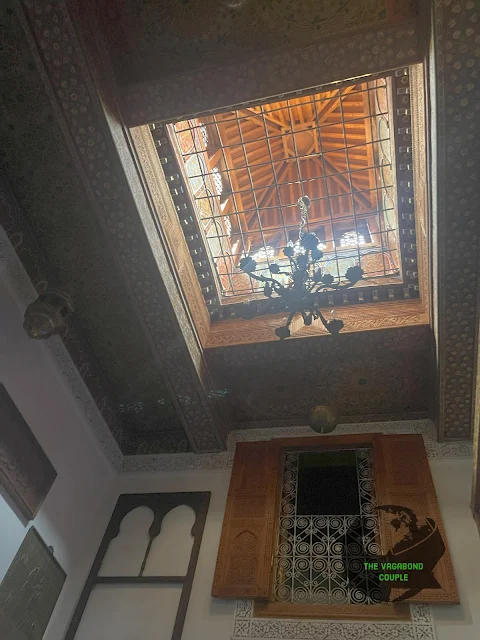

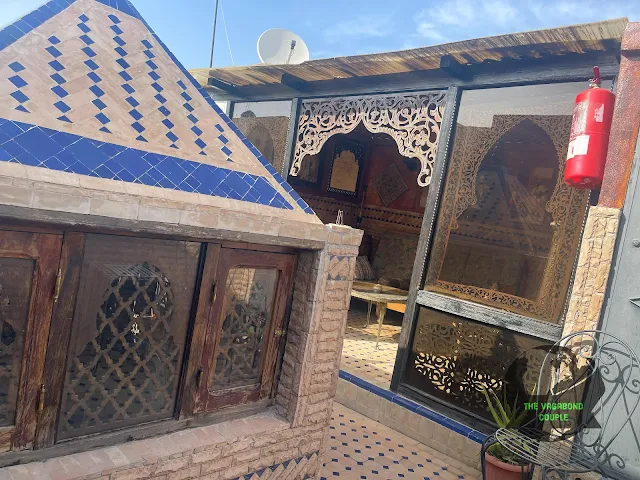
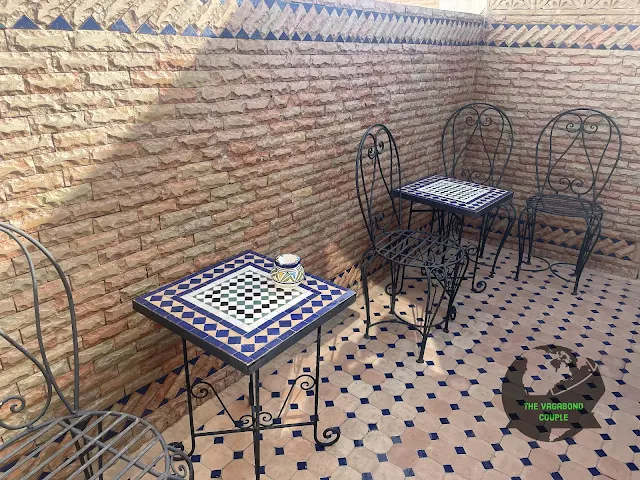

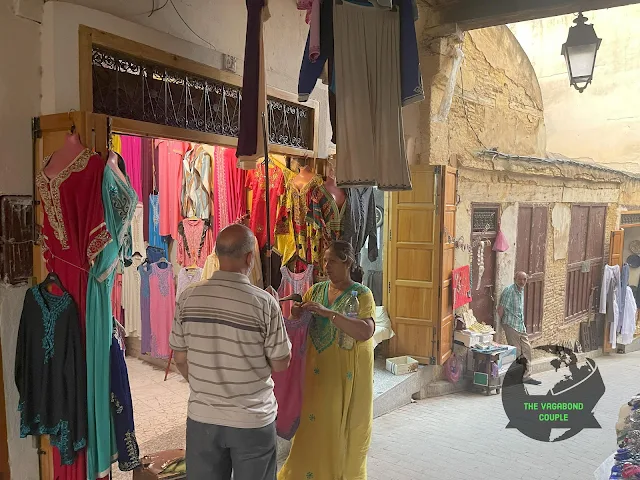



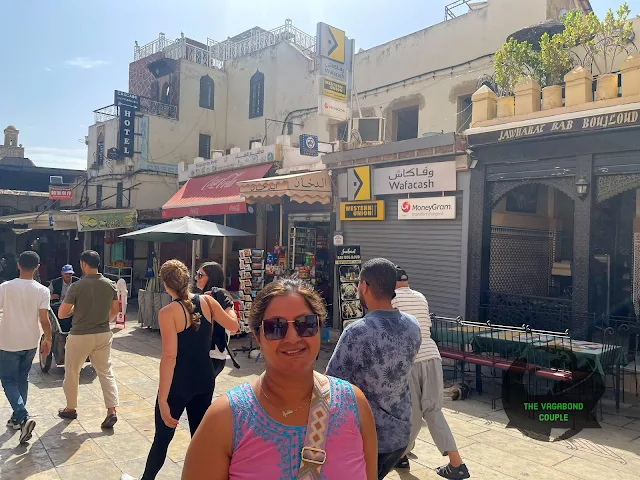
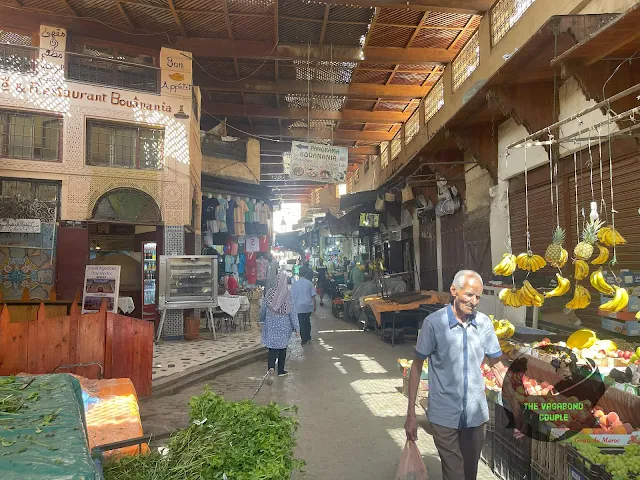
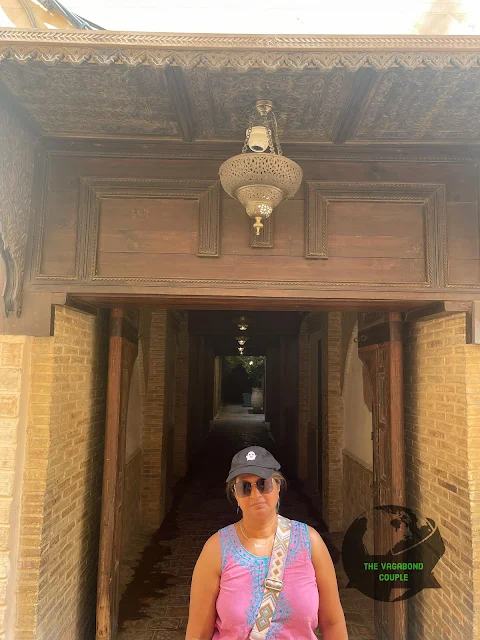

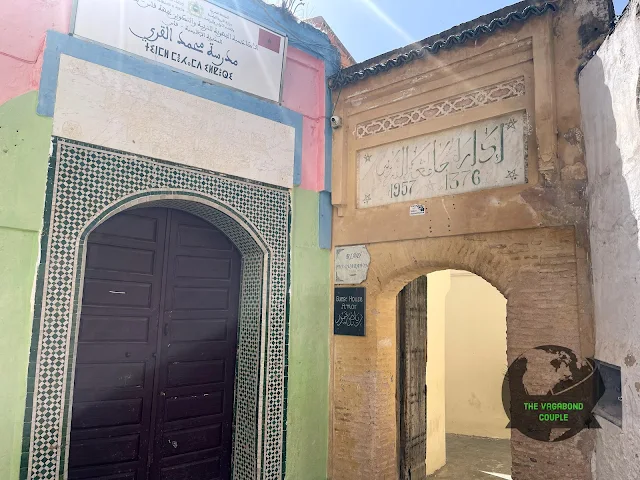

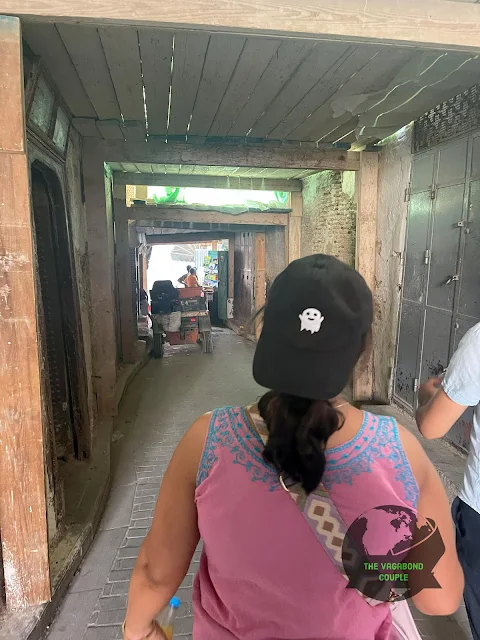

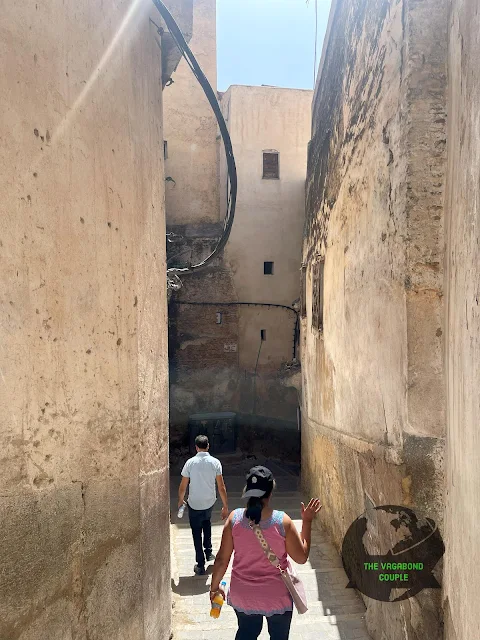
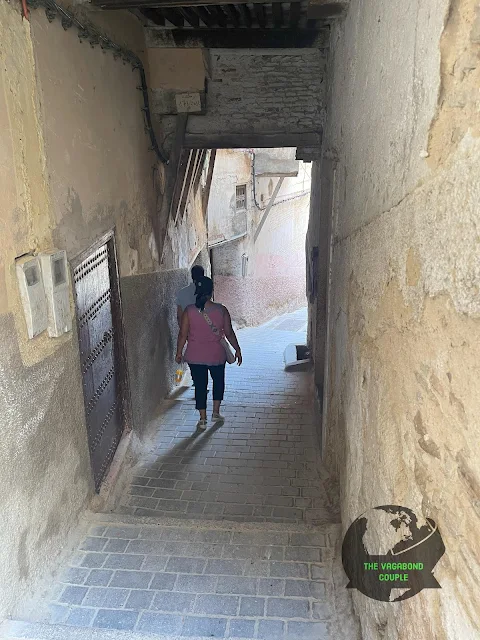
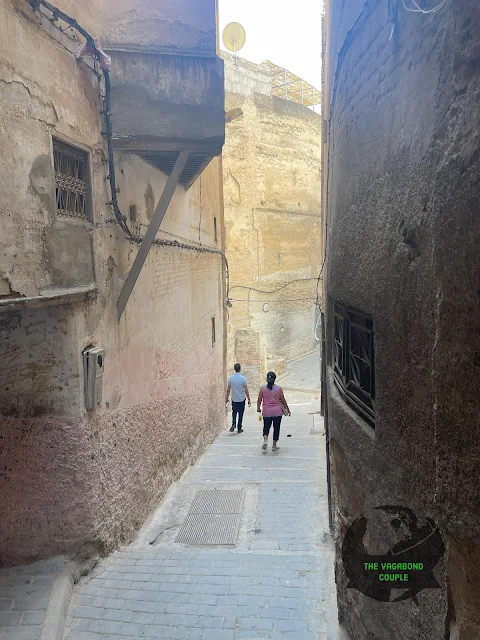
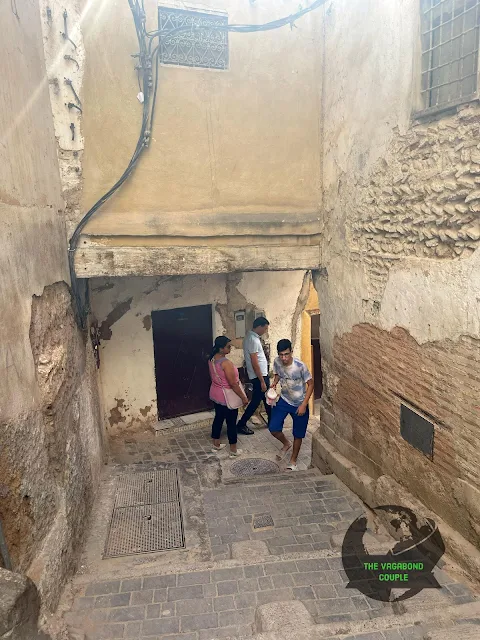

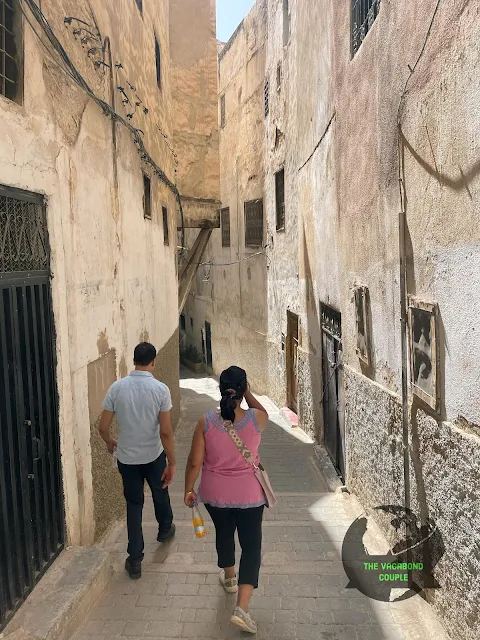
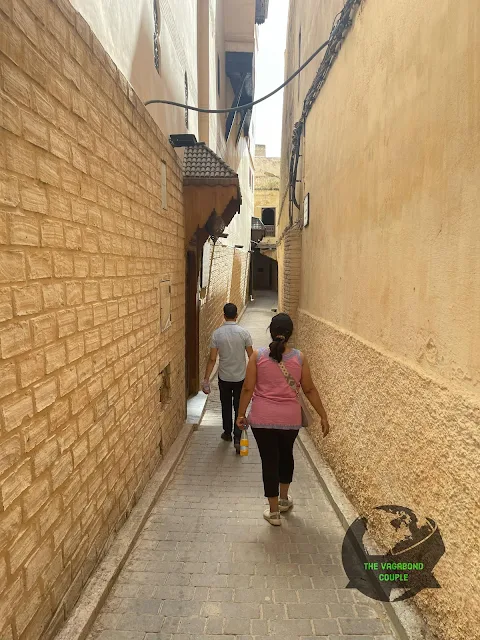
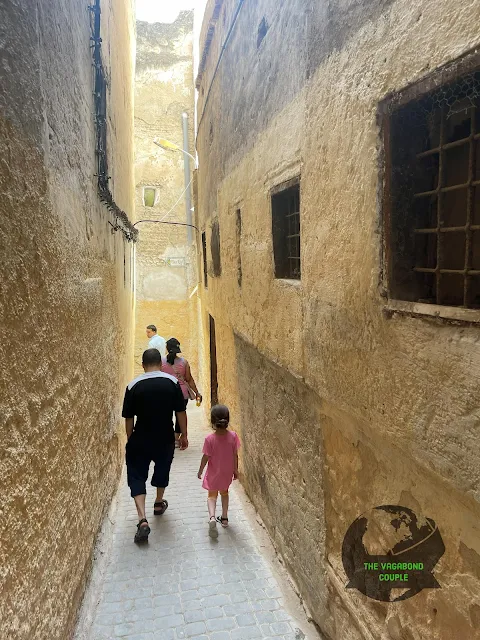
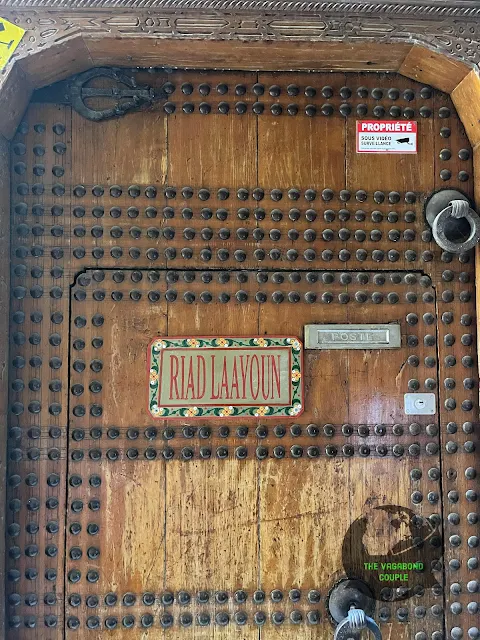


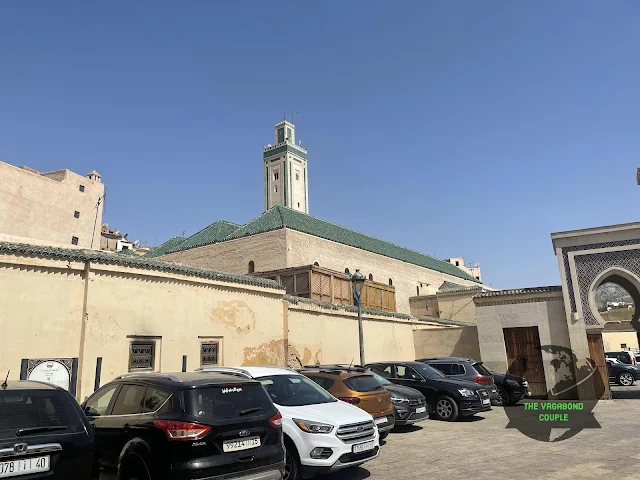
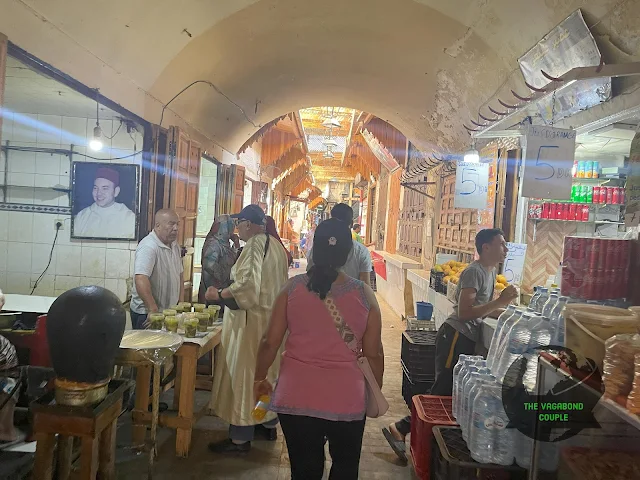
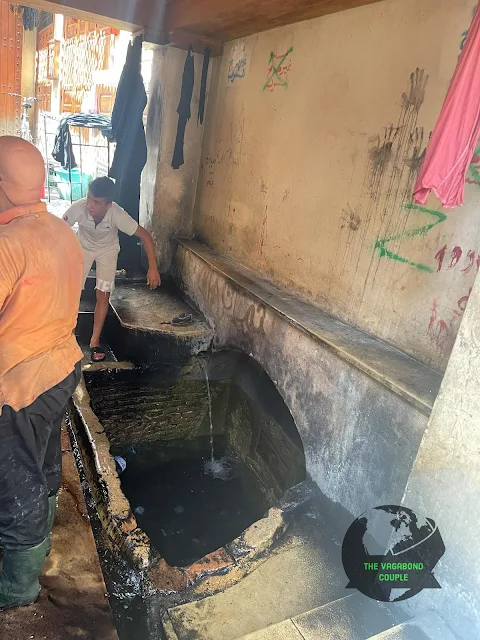
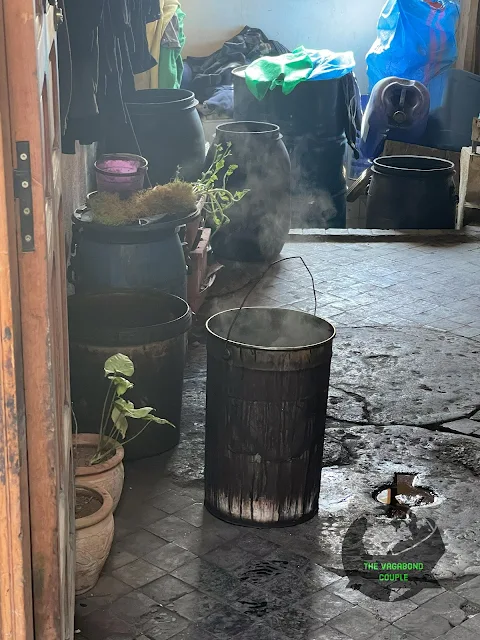

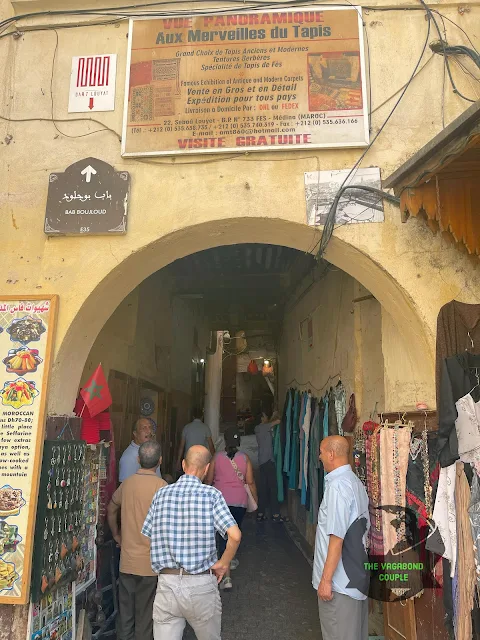
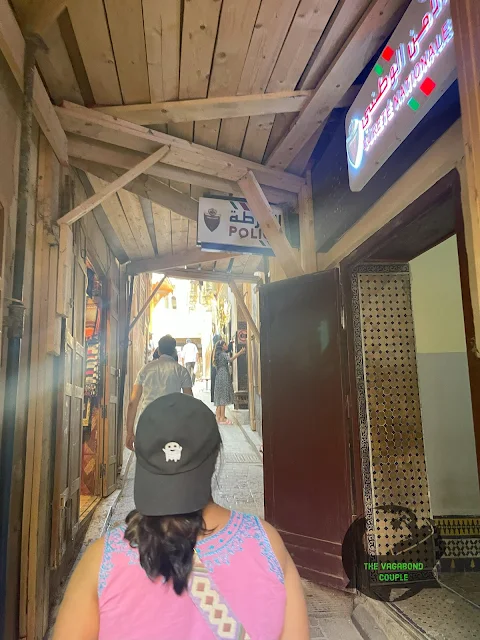



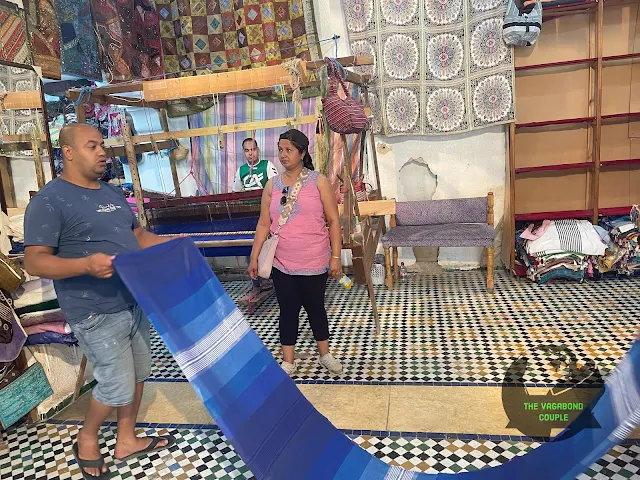
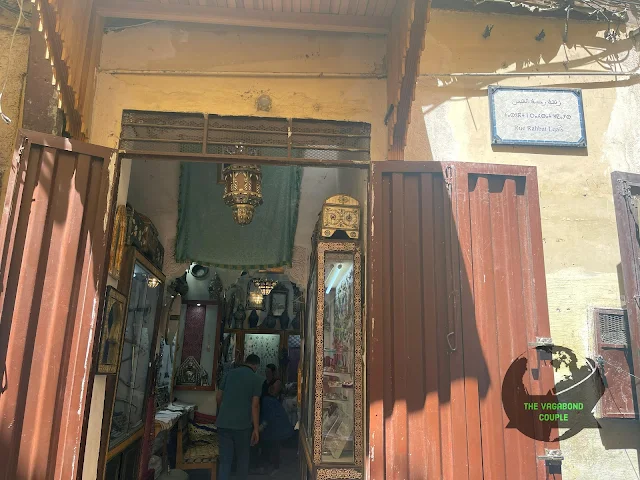
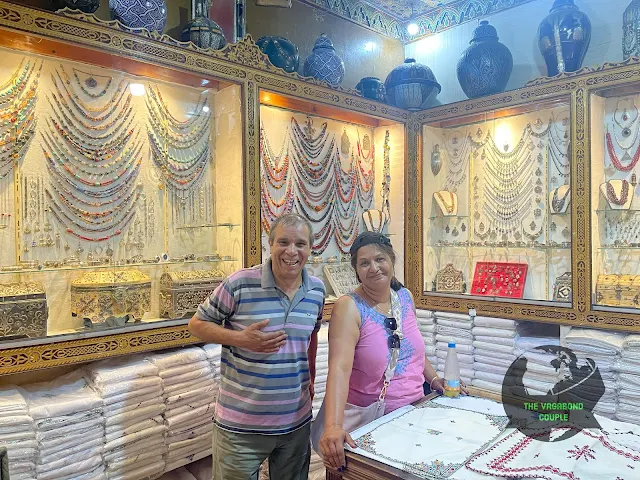




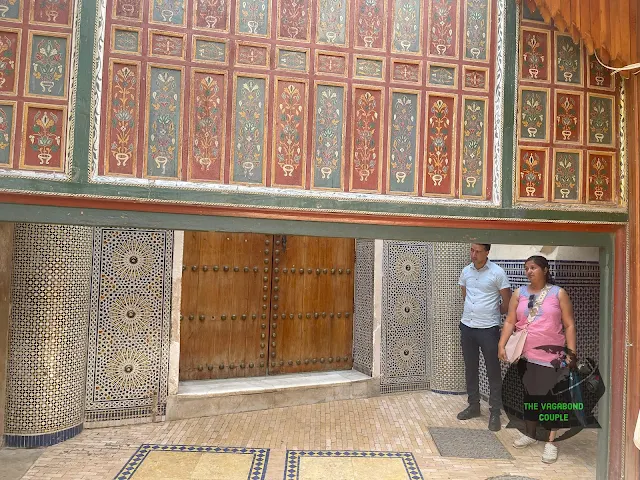




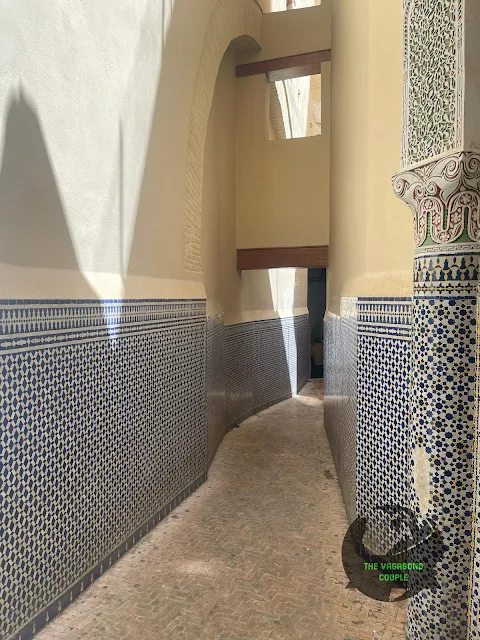
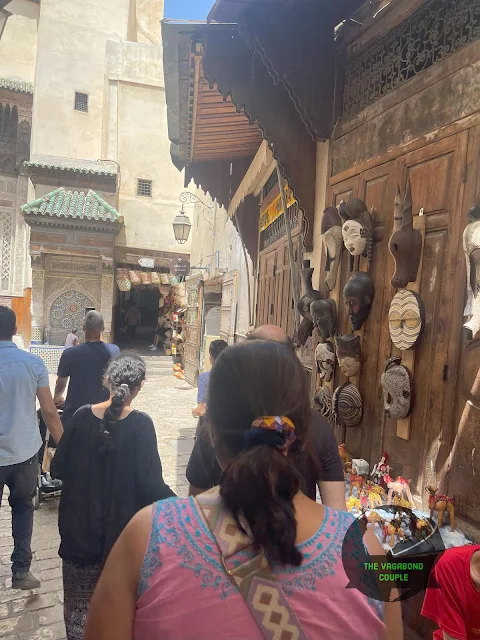

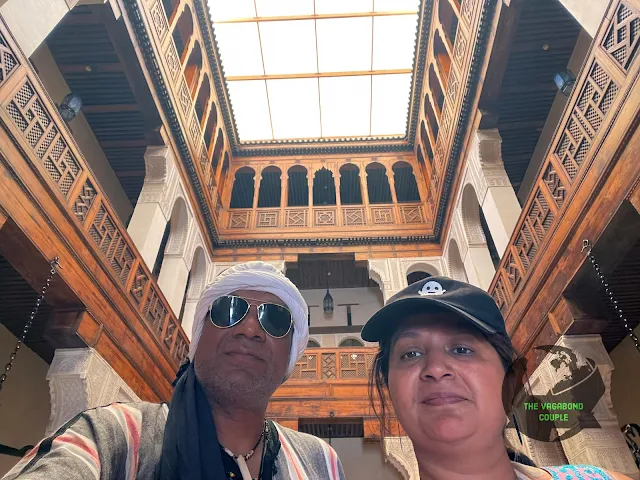
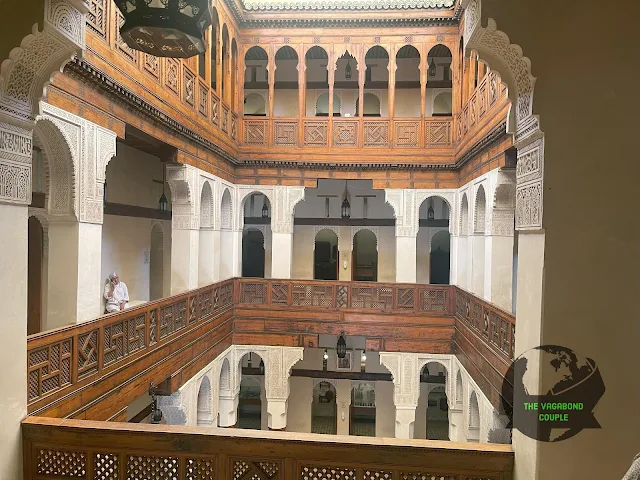
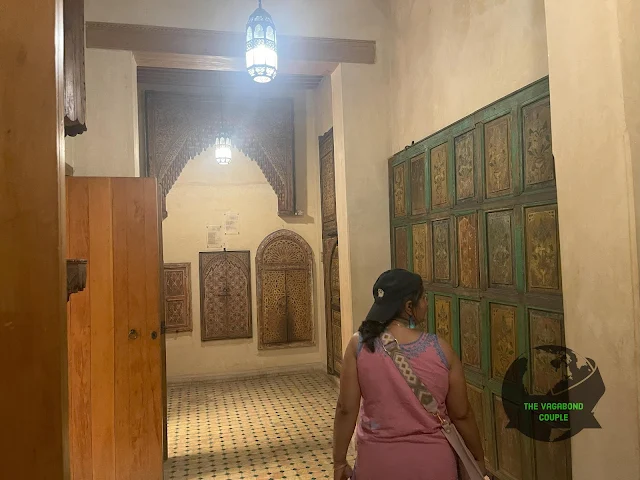
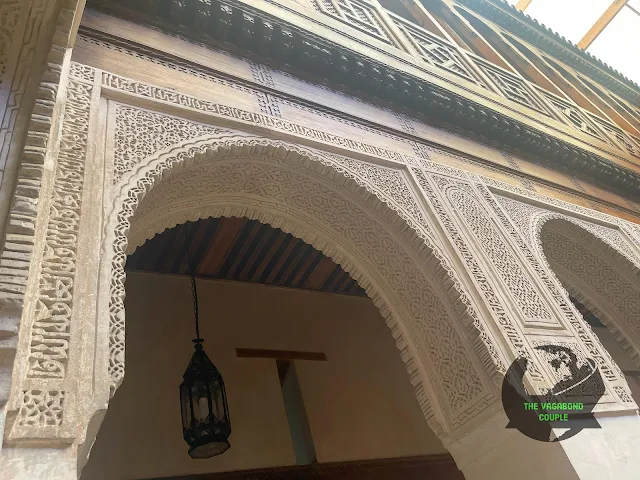

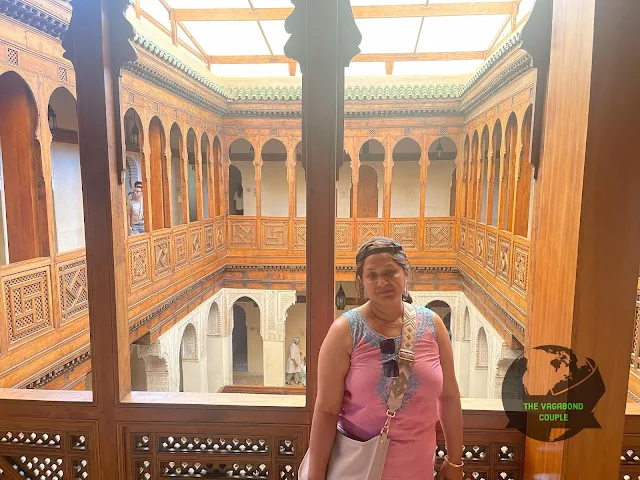
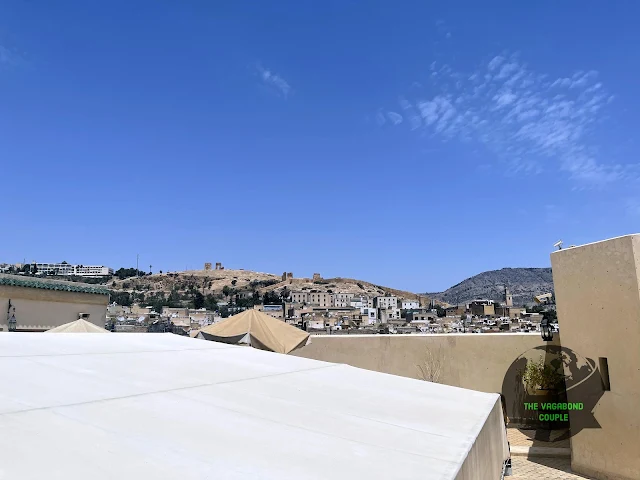

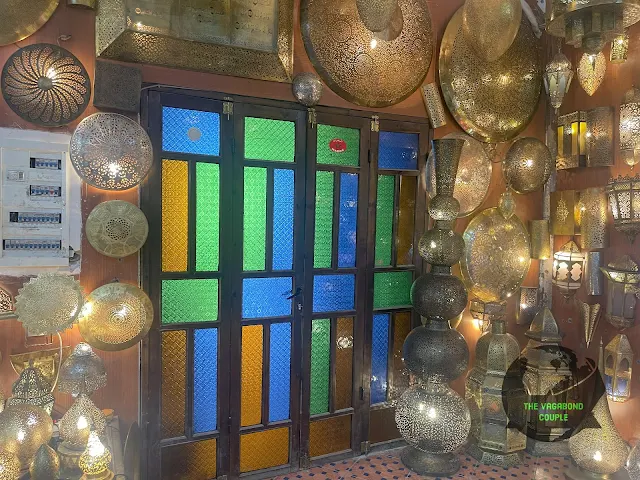

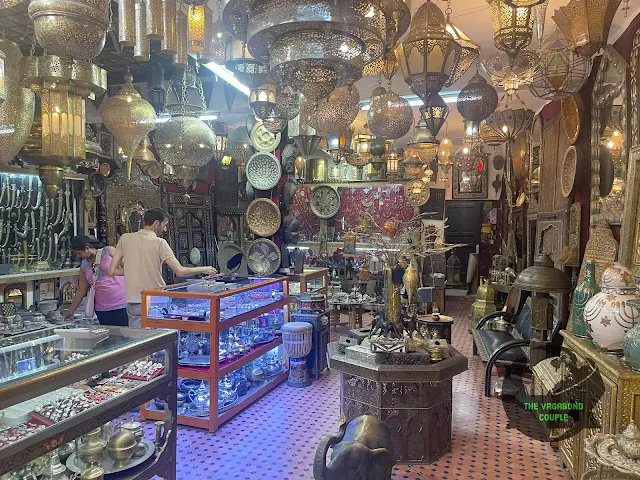
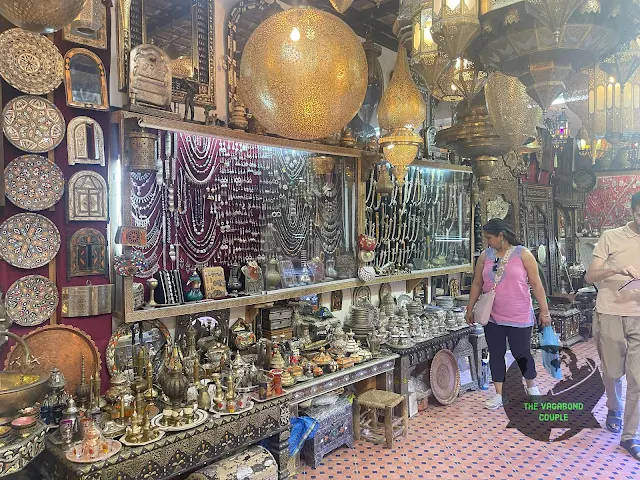

0 comments